
STEM for Kids
Empowering the next generation of innovators!

The Ultimate Environmental Science Project List: 50 Ideas for a Sustainable Future
Environmental science is an interdisciplinary field that explores the complex interactions between humans and the natural world. As our planet faces unprecedented challenges such as climate change, habitat destruction, and pollution, environmental science projects play a critical role in understanding and addressing these issues.
In this list, we’ve compiled 50 potential environmental science projects that cover a broad range of topics, from renewable energy and sustainable agriculture to wildlife conservation and waste management. These projects can serve as inspiration for students, curious kids, and anyone interested in making a positive impact on the environment. Whether you’re looking to tackle a local issue or contribute to global efforts, there’s no shortage of exciting and impactful projects to explore.
- Investigating the impact of plastic waste on marine life: This project would involve studying the effects of plastic waste on marine ecosystems, including the ingestion of plastics by marine organisms and the accumulation of plastic debris in ocean gyres.
- Examining the effects of air pollution on human health: This project would involve analyzing the health effects of exposure to air pollution, including respiratory illnesses and cardiovascular disease.
- Developing a more efficient and sustainable water treatment system: This project would involve designing and testing a water treatment system that is energy-efficient and sustainable, with minimal environmental impact.
- Evaluating the effectiveness of organic farming practices: This project would involve comparing the yields and environmental impacts of organic farming methods to conventional farming methods.
- Creating a composting program for a community or school: This project would involve developing a composting program to reduce waste and produce nutrient-rich soil for gardening.
- Investigating the environmental impact of mining operations: This project would involve studying the effects of mining on local ecosystems, including soil erosion, water pollution, and habitat destruction.
- Studying the biodiversity of a local ecosystem: This project would involve identifying and documenting the plant and animal species in a local ecosystem, and analyzing the interrelationships between them.
- Analyzing the effects of deforestation on climate change: This project would involve studying the impact of deforestation on carbon storage and the release of greenhouse gases, which contribute to climate change.
- Creating a solar-powered water desalination system: This project would involve designing and testing a system that uses solar energy to desalinate seawater, providing a sustainable source of fresh water.
- Evaluating the impact of climate change on wildlife habitats: This project would involve studying the effects of climate change on the habitats and migration patterns of wildlife, and developing strategies to mitigate the impacts.
- Developing a sustainable transportation system for a city or town: This project would involve designing and implementing a transportation system that is energy-efficient and sustainable, with minimal environmental impact.
- Investigating the potential of algae biofuels: This project would involve studying the potential of algae as a source of biofuel, and developing methods for cultivating and harvesting algae for energy production.
- Analyzing the effects of ocean acidification on marine ecosystems: This project would involve studying the impact of ocean acidification on marine organisms, including coral reefs and shellfish, and developing strategies to mitigate the impacts.
- Creating an energy-efficient home design: This project would involve designing and building a home that is energy-efficient and sustainable, with minimal environmental impact.
- Designing a sustainable urban agriculture system: This project would involve designing and implementing an urban agriculture system that is energy-efficient and sustainable, with minimal environmental impact.
- Studying the effects of pesticides on local wildlife: This project would involve studying the impact of pesticides on local wildlife, including birds, bees, and other pollinators, and developing strategies to mitigate the impacts.
- Developing a sustainable waste management program: This project would involve designing and implementing a waste management program that is energy-efficient and sustainable, with minimal environmental impact.
- Analyzing the impact of land use changes on local ecosystems: This project would involve studying the impact of changes in land use, such as urbanization and agriculture, on local ecosystems, and developing strategies to mitigate the impacts.
- Investigating the effectiveness of renewable energy sources: This project would involve analyzing the effectiveness of renewable energy sources, such as wind and solar power, in meeting energy demands and reducing greenhouse gas emissions.
- Creating a green roof or wall system for buildings: This project would involve designing and implementing a green roof or wall system that provides insulation, reduces heat absorption, and
- Studying the effects of noise pollution on wildlife behavior: This project would involve studying the impact of noise pollution on wildlife behavior, including changes in communication and reproductive success, and developing strategies to mitigate the impacts.
- Developing a sustainable tourism program for a local area: This project would involve designing and implementing a tourism program that is sustainable and minimizes the impact on local ecosystems and communities.
- Investigating the impact of microplastics on the environment: This project would involve studying the impact of microplastics, including their sources and effects on wildlife and human health, and developing strategies to reduce their release into the environment.
- Analyzing the effects of water scarcity on human communities: This project would involve studying the impact of water scarcity on human communities, including access to clean water and the effects on health and livelihoods, and developing strategies to address the issue.
- Creating a sustainable food distribution system: This project would involve designing and implementing a food distribution system that is sustainable and minimizes the impact on the environment while ensuring food security for all.
- Evaluating the impact of climate change on crop yields: This project would involve studying the impact of climate change on crop yields, including changes in temperature, rainfall, and soil quality, and developing strategies to adapt to the changes.
- Studying the effects of light pollution on nocturnal wildlife: This project would involve studying the impact of light pollution on nocturnal wildlife, including changes in behavior and ecological interactions, and developing strategies to mitigate the impacts.
- Developing a sustainable fishing program: This project would involve designing and implementing a fishing program that is sustainable and minimizes the impact on fish populations and marine ecosystems.
- Investigating the potential of geothermal energy sources: This project would involve studying the potential of geothermal energy as a source of renewable energy, and developing methods for harnessing and using it.
- Analyzing the impact of invasive species on local ecosystems: This project would involve studying the impact of invasive species on local ecosystems, including changes in biodiversity and ecological interactions, and developing strategies to mitigate the impacts.
- Creating a sustainable packaging system for products: This project would involve designing and implementing a packaging system that is sustainable and minimizes the environmental impact of products.
- Studying the effects of climate change on ocean currents: This project would involve studying the impact of climate change on ocean currents, including changes in temperature and circulation, and the effects on marine ecosystems and global climate.
- Developing a sustainable water supply system for a community: This project would involve designing and implementing a water supply system that is sustainable and provides access to clean water for all.
- Investigating the impact of deforestation on soil quality: This project would involve studying the impact of deforestation on soil quality, including changes in nutrient content and erosion, and developing strategies to restore degraded soils.
- Analyzing the effects of global warming on Arctic ecosystems: This project would involve studying the impact of global warming on Arctic ecosystems, including changes in ice cover and wildlife habitats, and developing strategies to adapt to the changes.
- Creating a sustainable urban planning system: This project would involve designing and implementing an urban planning system that is sustainable and minimizes the environmental impact of cities.
- Studying the effects of climate change on water availability: This project would involve studying the impact of climate change on water availability, including changes in precipitation and water storage, and developing strategies to adapt to the changes.
- Developing a sustainable energy storage system: This project would involve designing and implementing an energy storage system that is sustainable and minimizes the impact on the environment.
- Investigating the impact of ocean currents on marine life migration patterns: This project would involve studying the impact of ocean currents on the migration patterns of marine organisms, including changes in distribution and population dynamics, and developing strategies to mitigate the impacts.
- Analyzing the effects of urbanization on local ecosystems: This project would involve studying the impact of urbanization on local ecosystems, including changes in biodiversity and habitat fragmentation, and developing strategies to mitigate the impacts.
- Creating a sustainable transportation infrastructure for freight: This project would involve designing and implementing a transportation infrastructure that is sustainable and minimizes the impact of freight transportation on the environment.
- Studying the effects of climate change on bird migration patterns: This project would involve studying the impact of climate change on bird migration patterns, including changes in timing and range, and developing strategies to adapt to the changes.
- Developing a sustainable food production system for cities: This project would involve designing and implementing a food production system that is sustainable and provides fresh, healthy food for urban populations.
- Investigating the impact of sea level rise on coastal ecosystems: This project would involve studying the impact of sea level rise on coastal ecosystems, including changes in erosion and flooding, and developing strategies to adapt to the changes.
- Analyzing the effects of drought on soil health: This project would involve studying the impact of drought on soil health, including changes in nutrient content and erosion, and developing strategies to restore degraded soils.
- Creating a sustainable pest management system for agriculture: This project would involve designing and implementing a pest management system that is sustainable and minimizes the use of harmful pesticides and herbicides.
- Studying the effects of air pollution on plant growth: This project would involve studying the impact of air pollution on plant growth and productivity and developing strategies to mitigate the impacts.
- Developing a sustainable wildfire management program: This project would involve designing and implementing a wildfire management program that is sustainable and minimizes the impact on local ecosystems and communities.
- Investigating the impact of climate change on insect populations: This project would involve studying the impact of climate change on insect populations, including changes in distribution and abundance, and developing strategies to adapt to the changes.
- Analyzing the effects of e-waste on the environment: This project would involve studying the impact of electronic waste on the environment, including the disposal and recycling of electronic devices, and developing strategies to reduce the release of harmful materials into the environment.
In conclusion, environmental science projects are essential for understanding and addressing the challenges that our planet faces. From mitigating the effects of climate change to protecting biodiversity and promoting sustainability, these projects play a critical role in shaping our future.
The 50 projects we’ve listed provide a diverse range of options for individuals and groups looking to make a positive impact on the environment. Whether it’s through scientific research, engineering design, or community-based initiatives, there are countless ways to get involved and contribute to a more sustainable and equitable world. By taking action and pursuing these projects, we can work towards a better future for ourselves and the planet we call home.
Leave a Reply Cancel reply
Your email address will not be published. Required fields are marked *
Save my name, email, and website in this browser for the next time I comment.

Environmental Science Experiments
Studying the environment and how to overcome environmental problems is something every student should do. We all share this planet as our home, and it is up to all of us to become educated in the challenges facing it and how we need to change to protect it. Today we are sharing ideas for Environmental Science Experiments you can do with your students from elementary through high school.
Hands On Environmental Science for Students
What you will discover in this article!
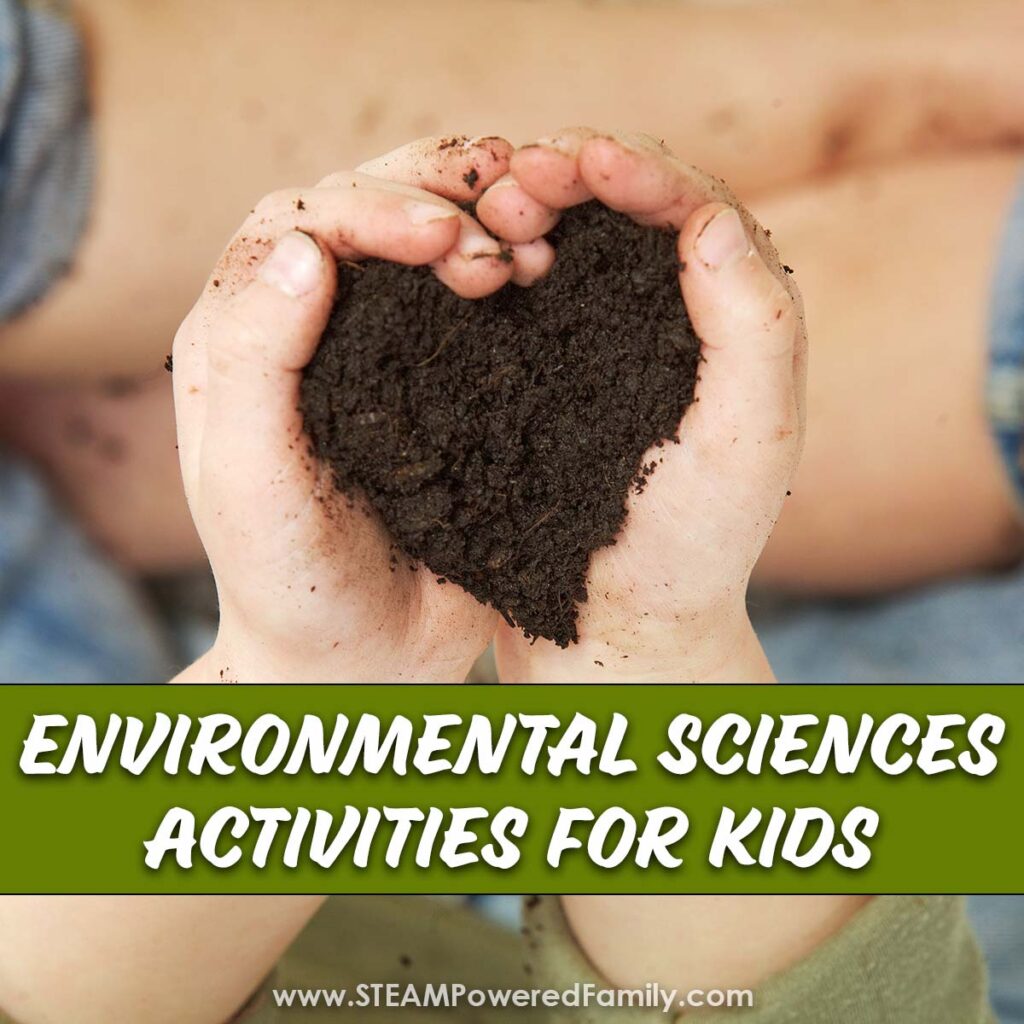
Environmental Sciences was my original degree program when I first enrolled in University. I had always been passionate about wildlife management and conservation in particular, and it was my dream to work on protecting Canadian wildlife and their habitats as an environmental scientist. Sadly, after my second year I developed a number of severe health issues that forced me to change my degree program, but my passion for the environment has never waivered.
What is Environmental Science?
Environmental science is an interdisciplinary field. What does that mean? It simply means that it brings together a number of different disciplines and studies to focus on one area, the environment. Specifically it integrates physics, biology, chemistry, and geography, ecology, chemistry, plant science, zoology, mineralogy, oceanography, limnology, soil science, geology and physical geography, and atmospheric science. Certain environmental studies also integrate history, policy, politics, psychology, sociology and government studies. This is a very diverse field with a lot of demand as more and more we are focusing on finding ways to protect our planet.
Why is Environmental Science Important?
It is no secret, as societies have developed and grown throughout history, the impact on Earth and natural resources has not always been positive. For us to continue to develop and thrive on this planet it is important that we also focus on the environmental impacts of our actions.
Through environmental science studies, we see how our own health and the health of our environment are intertwined. We need to protect our planet to protect ourselves now and for future generations. Environmental science research and sustainable education for our students is crucial to keeping our ecosystems in balance, reversing damage done in the past, and preventing future damage and destruction.
Through environmental sciences we can find ways to continue to grow and thrive.
What do you learn in Environmental Sciences?
Environmental science is the study of nature, the environment, the planet, and everything living on this planet to identify and solve issues relating to the relationship we have with the natural world. It includes many subjects such as biology, chemistry, physics, geology, oceanography, zoology and many more types of science, in order to inform our understanding of the Earth and how to protect it.
As you can see this field is extremely broad, so there are many, many activities we can do with our kids that can fall under the umbrella of Environmental Sciences and so we can start fostering that passion to protect our planet.
Environmental Science Experiments and Activities for Kids
In order to make the environment a priority, it is important that we start incorporating it into our children’s education from an early age. One of the best ways I have found to help raise Earth conscience kids with an understanding of environmental issues is by doing hands on activities that really make an impact. We can start this at a very early age by incorporating simple nature and eco-friendly activities into our lessons, then as students grow and mature, we can start doing more advanced experiments.
To simplify things I have started with the most simple environmental activities for young kids first, then gradually increase the complexity of the activities until we reach experiments for high schoolers. The goal is to keep the lessons about the environment age appropriate and to foster that curiosity and passion for learning how to care for planet Earth.
Ready to dive into Environmental Sciences with your kids? Let’s go!
Nature Senses Detective
In this Nature Senses Detective activity young kids start to connect with nature using their senses. They start by going out into nature and intentionally and consciously use all of their senses to explore things in nature. Then, using items they discover in nature, have them see if they an identify the items by using only one sense.
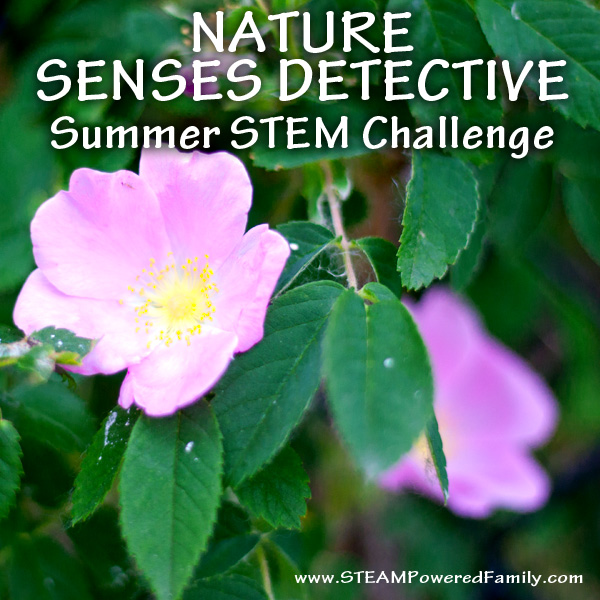
Rewilding and Homemade Seed Bombs
Native seeding is a wonderful way to rewild areas that have been damaged due to human activity. They are also a lot of fun for kids to make and use. We have two different ways of making seed bombs , plus instructions for making seed paper . Don’t forget to make a seed bomb launcher !
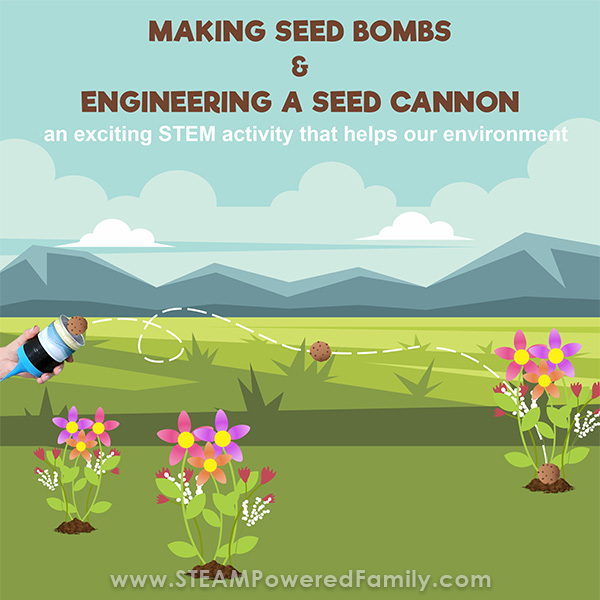
Layers of the Earth Activity
Although Environmental Sciences tends to focus only on the crust and atmosphere of our planet, it is important to also understand the inner workings and layers of Earth. Our favourite activity for exploring this is to make beautiful Layers of the Earth Soap . We also have a version where kids can make a Layers of the Ocean soap for an Ocean Sciences study.
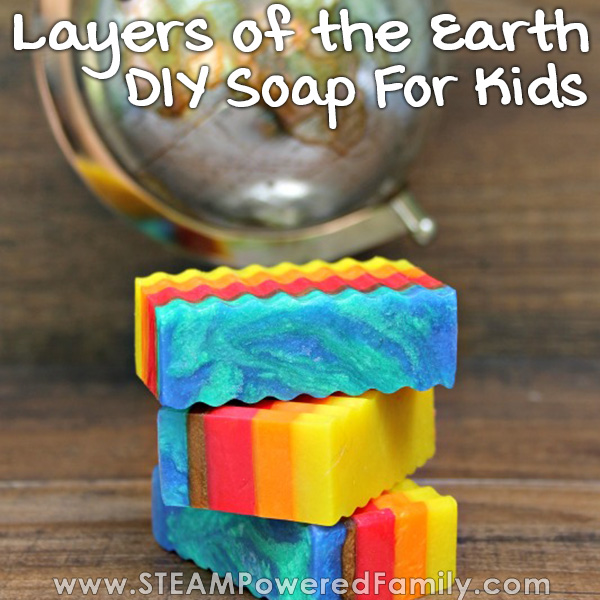
Sky Science
The sky is something we all can see every day, but the colours of the sky varies depending on where you are and what time of day it is. It can be vibrant blue or pale blue, pink, orange and even red. These colours are caused by light moving through the atmosphere. In this Sky Science experiment we explore how particles in the atmosphere affect what colours we see in the sky.
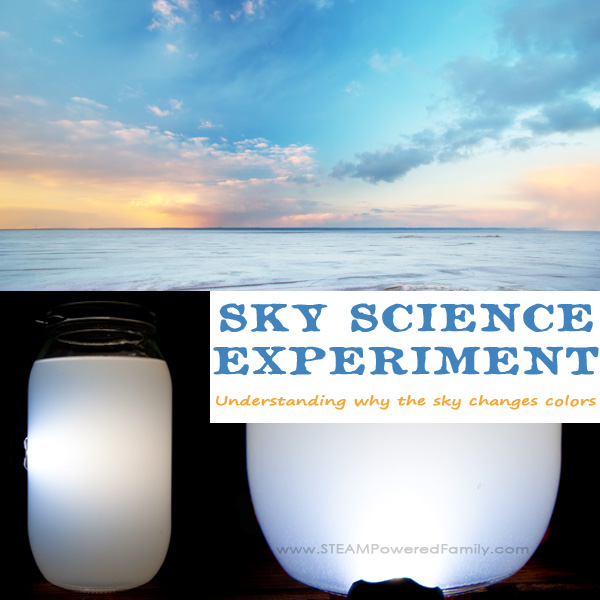
Oil Spill Activity – How to clean up oil on water
This is a very simple oil spill cleanup experiment , but one that teaches an important lesson about oil spills and pollution in our oceans and waterways. All you need is a bowl of water, some oil (vegetable or baby oil all work fine), and a variety of tools to try and clean up the oil. Then challenge your students to try and clean up the oil.
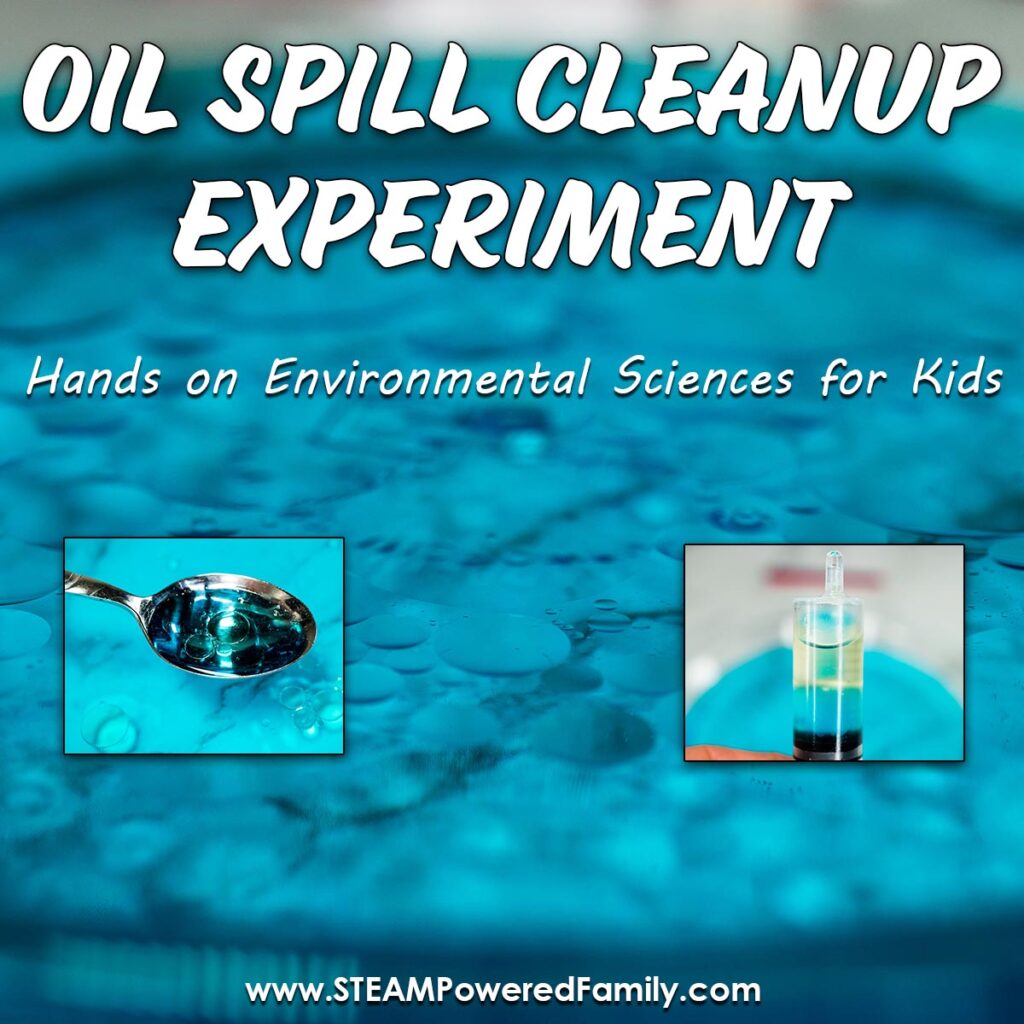
Water pollution and safety is a concern all over the world. In this Water Lab experiment students will collect samples from a variety of locally available water sources, then run some simple tests to compare the samples.
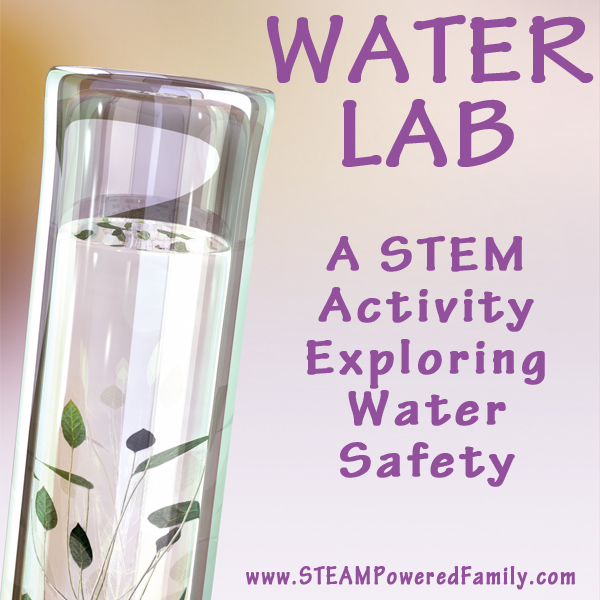
Water Pollution Experiment
Water pollution has a big effect on living beings. Whether it is plants or animals. If it is alive on this planet, it requires water. So when water becomes polluted it can have a big effect on life. In this Water Pollution experiment we explore the effect of water pollution on plant life.
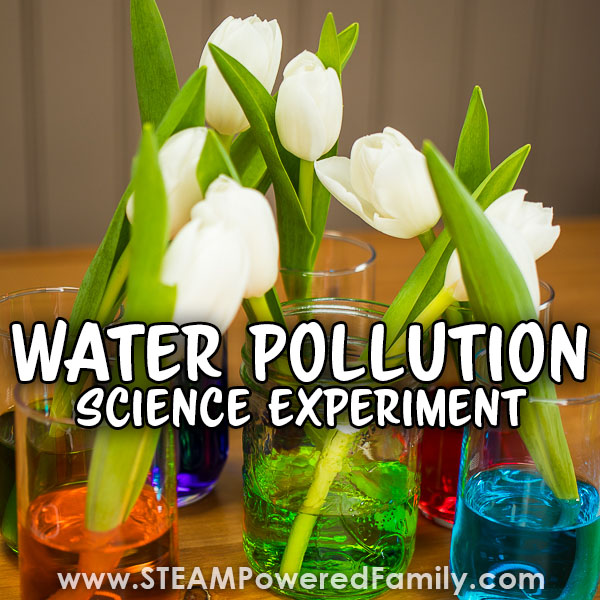
Weather Science
The weather is a big part of the study of the environment. There are a number of ways you can study the weather. Some rain related activities would be doing a water cycle experiment , building a rain gauge or making a DIY barometer .
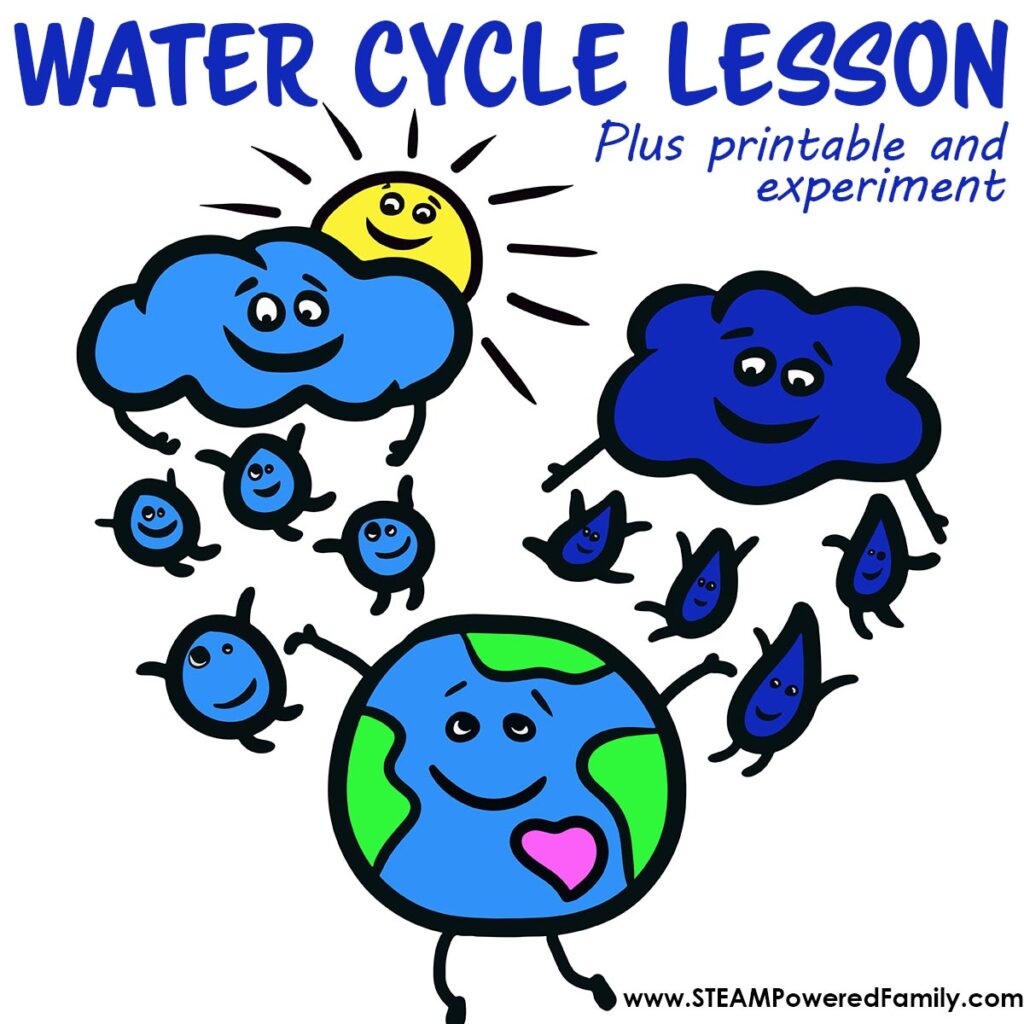
Renewable Energy Activity – Build a Windmill
This activity has a wonderful book you can incorporate into a unit study, The Boy Who Harnessed the Wind. It is a true story of a boy who taught himself how to build windmills to bring energy to his village. It is available in a variety of formats for all age ranges. Then challenge your kids to build their own windmill .
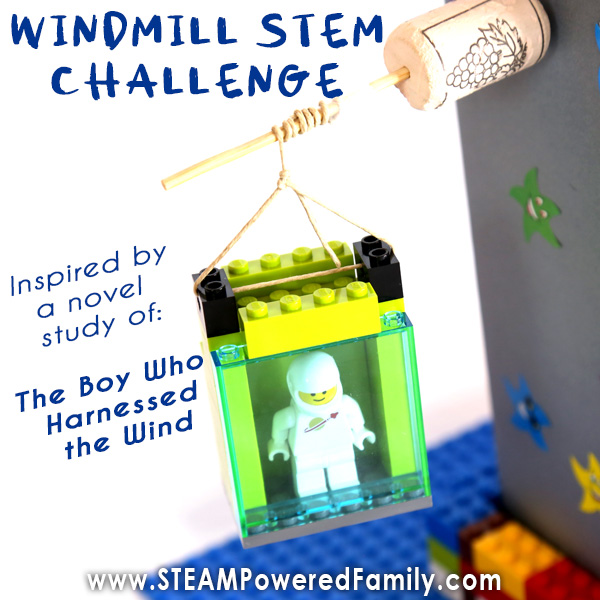
Natural Energy Sources – Building Food Batteries
A fun activity to do with kids is learning about natural energy sources, such as building batteries out of food. In the past we have built Potato Batteries , Lemon Batteries and even Pumpkin Batteries . This is a great way to get kids thinking differently about energy.
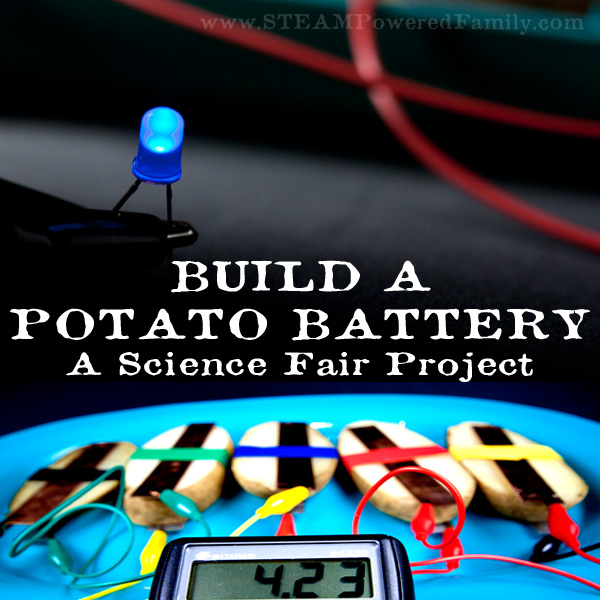
Making Bioplastics
Plastic is a huge issue all over the world when it comes to environmental concerns. As part of studies into plastic, have your students learn how to make bioplastics. It is an incredible way to get hands on with this complex subject. Learn how to make bioplastics with Milk Plastic or Gelatin Plastic .
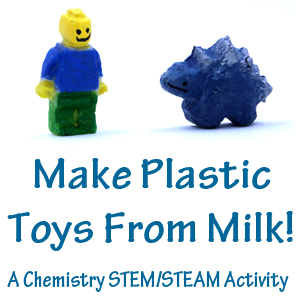
Acid Rain Experiment
Acid rain is a major environmental concern across the planet. The impact of acid rain on various ecosystems is well documented, but it may be difficult for students to understand. In this acid rain science experiment we see the impact of acid rain on plants. The results are impactful and highly educational.
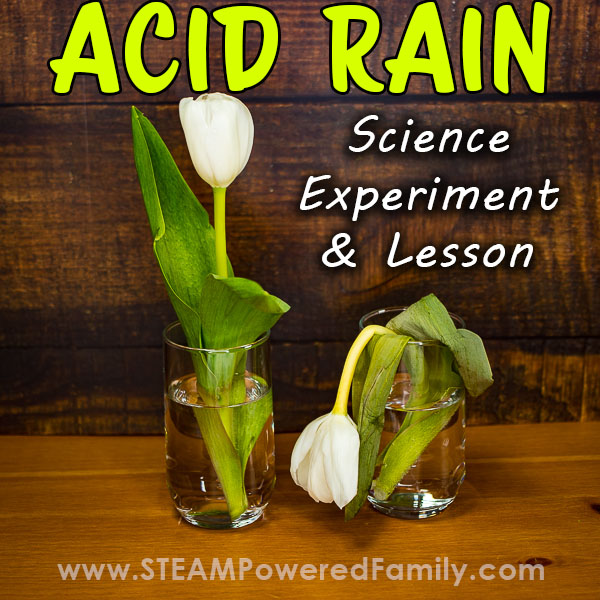
Greenhouse Effect Experiment
This Greenhouse Effect experiment is probably one of my favourite of all time that I did with my older kids. My kids often ask about climate change as they seek to better understand what is happening on our planet. In this experiment they were able to get hands on and develop a much greater understanding of the principles behind the Greenhouse Effect.
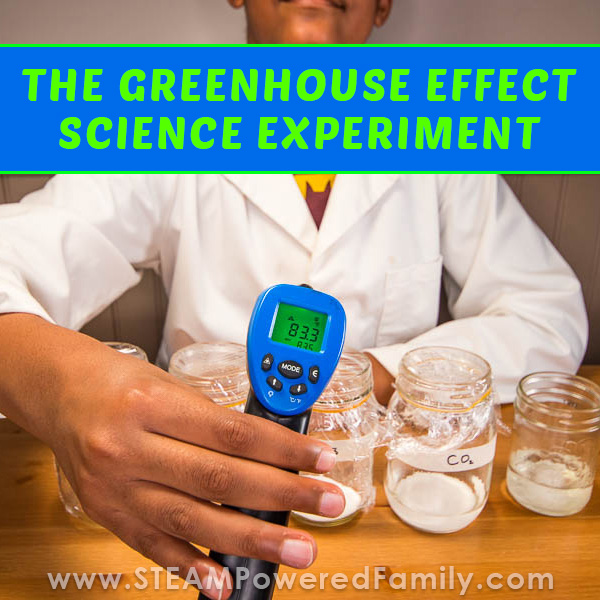
Studying the environment is a very important part of every child’s education. We all need to understand how our activities are impacting Earth and how we can lessen any damage we are causing. We also need more change makers in this area. Innovative and creative individuals who think outside of the box and will discover better ways to address the environmental issues affecting us all.
Want more activities learning about the Earth? Check out our comprehensive guide to Earth Day Activities for Kids .
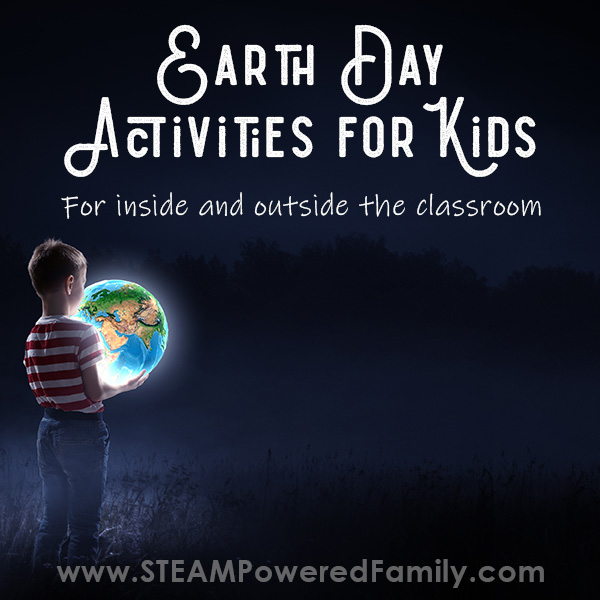
5 Days of Smart STEM Ideas for Kids
Get started in STEM with easy, engaging activities.
- Grades 6-12
- School Leaders
Have You Seen Our List of Favorite Graphic Novels?
Every product is independently selected by our team of teacher-reviewers and editors. Things you buy through our links may earn us a commission.
61 Wet and Wild Outdoor Science Experiments and Activities
The whole world is one big science classroom.
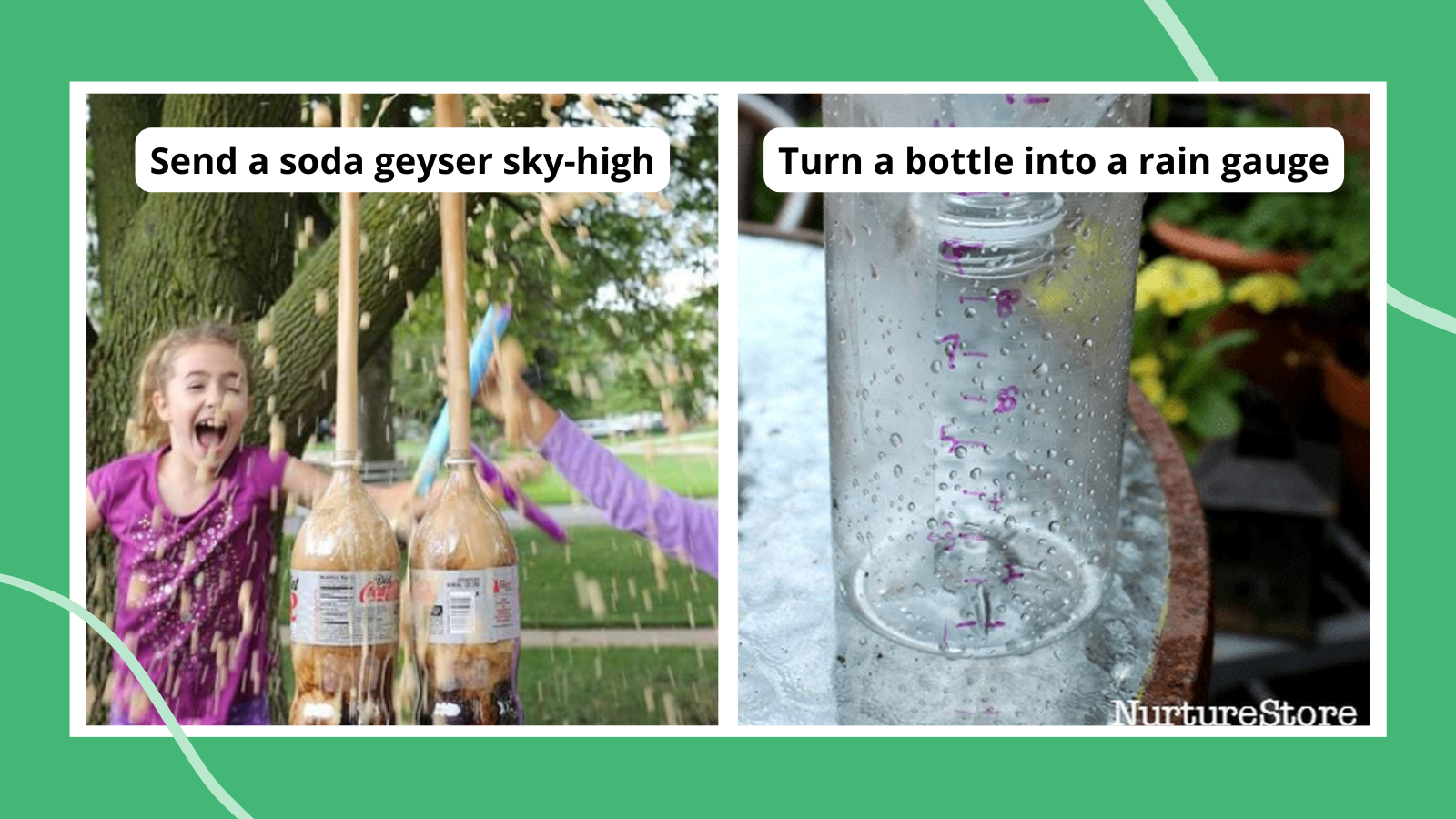
The only thing more fun than hands-on science is taking it outside! These outdoor science experiments and activities are perfect for taking advantage of sunny days. Fly kites, dissect flowers, experiment with sound and water, and so much more! There is something on our list for everyone from adults all the way down to toddlers.
You’ll only need simple supplies for most of these, so any teacher or family can head out to learn about chemistry, biology, physics, and more. To make it even easier to find the right outdoor science activities, we’ve rated each one for difficulty:
- Easy: Simple, short activities you can do with little or no prep needed.
- Medium: These activities take a little longer or require a few extra supplies but are still fairly simple.
- Advanced: Activities that require more unusual supplies or complex skills.
Outdoor Science Experiments That Get a Little Messy
Nature and wildlife outdoor activities, weather and climate outdoor science experiments, more outdoor science experiments and activities.
1. Wrap a watermelon in rubber bands
You’ve probably seen videos of this making the rounds online, so why not try it out yourself? This is one of those outdoor science experiments that’s easy to do, but make sure you wear safety equipment like goggles. (Medium)
2. Send a geyser sky-high
This is one of those outdoor science activities that simply can’t be done anywhere other than outdoors. Kids will marvel at the chemical reaction that sends diet soda shooting high in the air when Mentos are added. (Medium)
Learn more: Mentos and Coke Experiment (Plus Free Worksheet!)
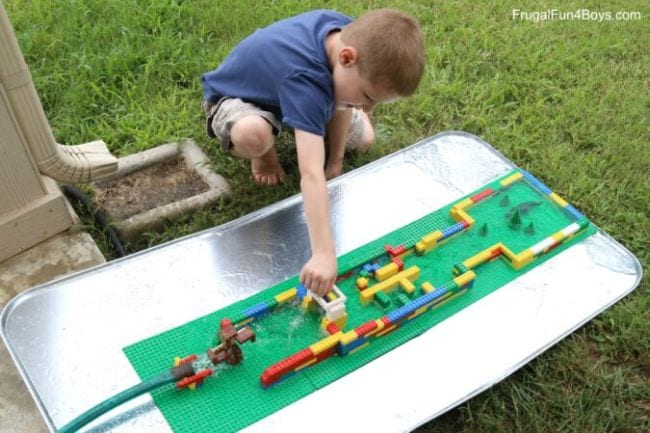
3. Construct a LEGO waterwheel course
Explore the power of water with a cool homemade LEGO water course that includes a dam and a water wheel. This engineering project is fun to play with when you’re done. (Medium)
Learn more: LEGO Course
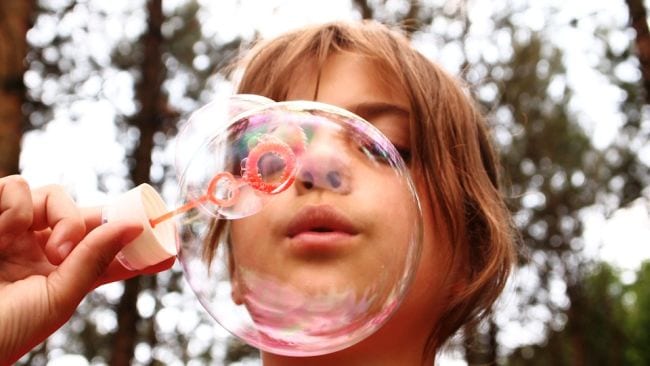
4. Find the best soap bubble solution
It’s easy to mix your own soap bubble solution with just a few ingredients. Let kids tweak the recipe to find the best proportion of ingredients to blow the longest-lasting bubbles with this fun outdoor science experiment. (Medium)
Learn more: How To Make a Homemade Bubbles Mixture at The Spruce Crafts
5. Blow giant bubbles
Bubbles are part of many fun outdoor science experiments. Once you’ve blown the longest-lasting bubbles, move on to creating the largest bubbles you’ve ever seen! Learn how in the video. (Medium)
6. Brew some elephant toothpaste
This experiment is popular with kids and adults alike! Don your safety goggles, mix a few ingredients, and watch the “elephant toothpaste” fly! (Medium)
Learn more: Elephant Toothpaste Experiment Plus Free Worksheet
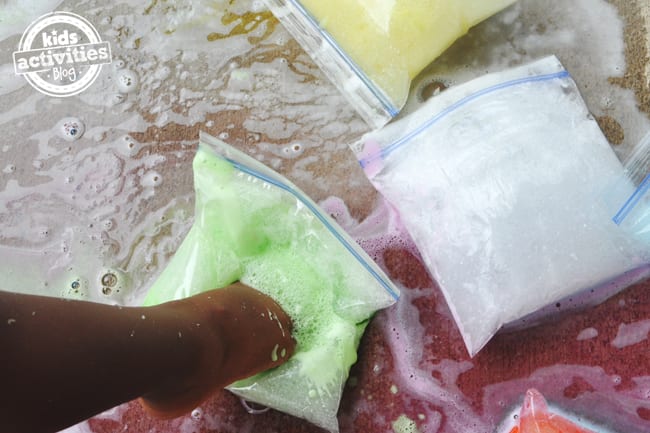
7. Explode plastic baggies
Vinegar and baking soda experiments are always a big hit with kids, and this one is no exception. They’ll love seeing the bags pop from the chemical reaction, and you’ll be glad the mess is outside. Plus, learn how to make a DIY volcano here! (Easy)
Learn more: Exploding Baggies
8. Conduct an egg drop
Here’s another classic outdoor science project you won’t want to move inside—the egg drop. Challenge kids to engineer a container that will protect an egg from a long fall (this is especially fun to do from upper-story windows). (Medium)
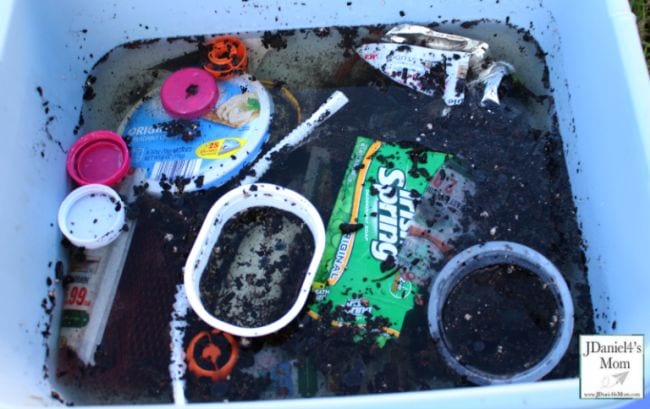
9. See water pollution in action
Learn about the challenges of cleaning up polluted water sources like rivers and lakes with this interesting outdoor science activity. Pair it with a visit to a local water-treatment plant to expand the lesson. (Medium)
Learn more: Water Pollution Experiment
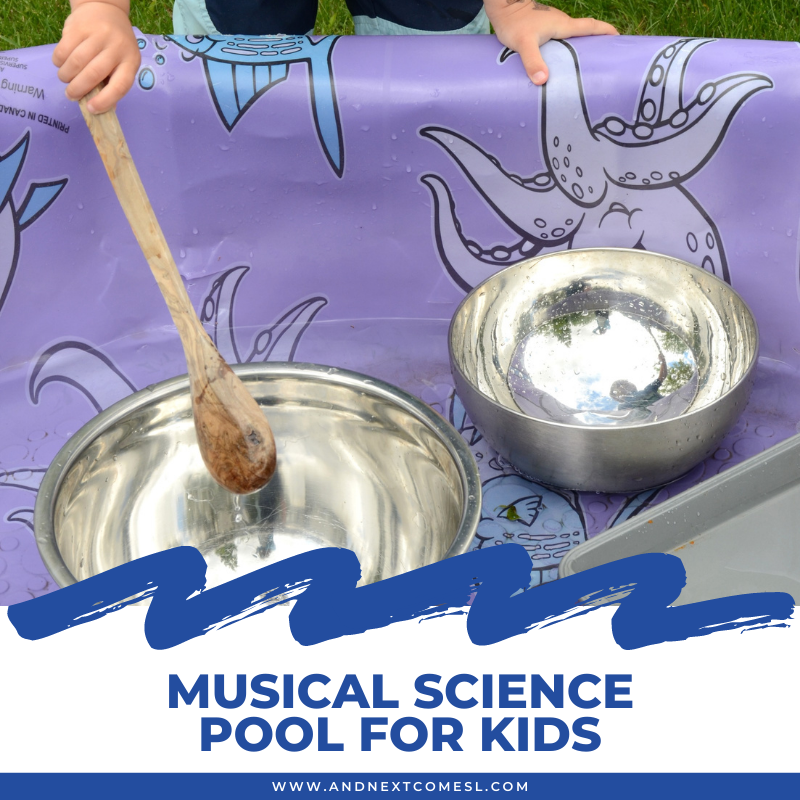
10. Set up a musical science pool
This project is equally fun as a sensory experience and as a science experiment. Fill a kiddie pool with water, then place metal mixing bowls of different sizes inside. Finally, let kids experiment with different combos of waters, bowls, and drumsticks (i.e., wooden spoons). (Medium)
Learn more: Musical Science Pool
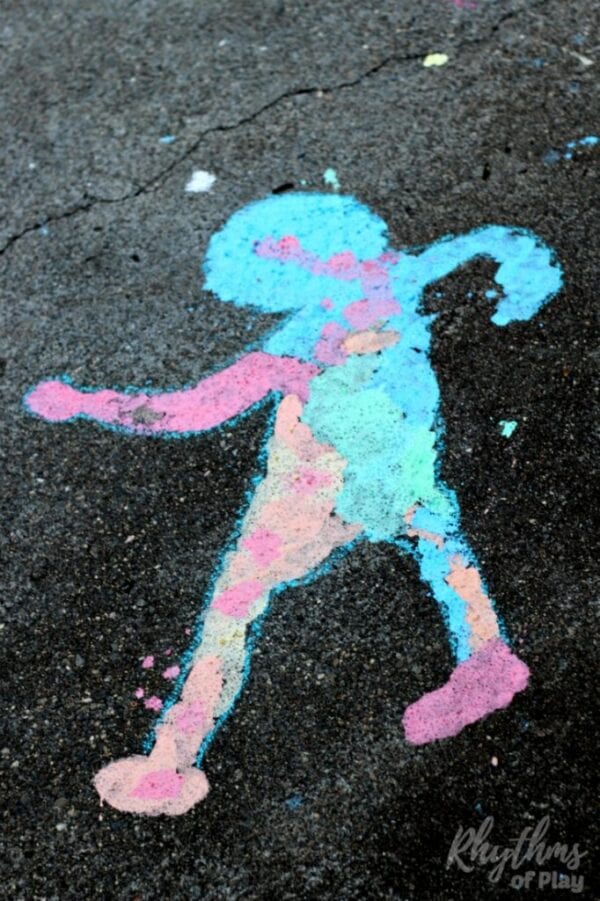
11. Paint a shadow with homemade chalk paint
Head outside and have kids trace the outlines of their shadows. Then mix up some homemade chalk paint and let kids get creative painting their shadows. (Medium)
Learn more: Shadow Sidewalk Chalk Art
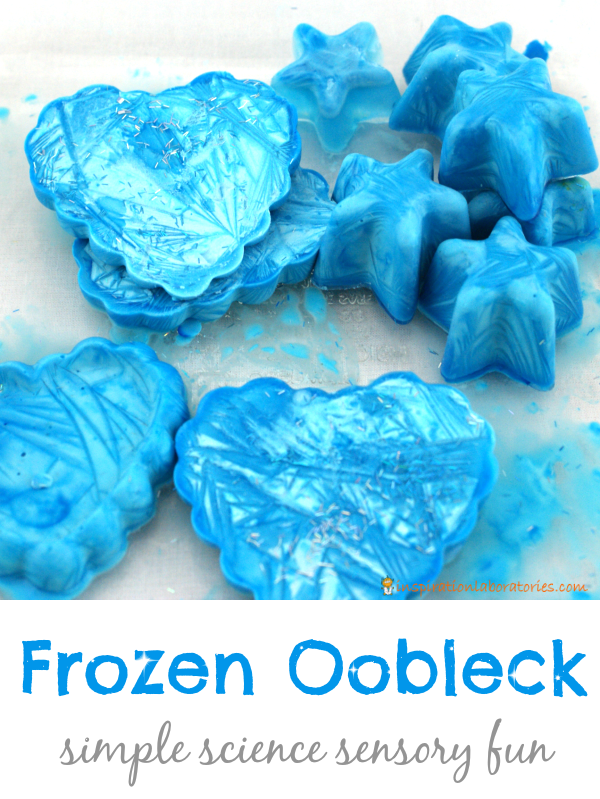
12. Make and melt frozen oobleck
Oobleck is a strange non-Newtonian fluid that’s both fun and fascinating to play around with. For a new twist on this classic experiment, freeze some oobleck, then take it out into the sun and see what happens when it melts. (Medium)
Learn more: Frozen Oobleck
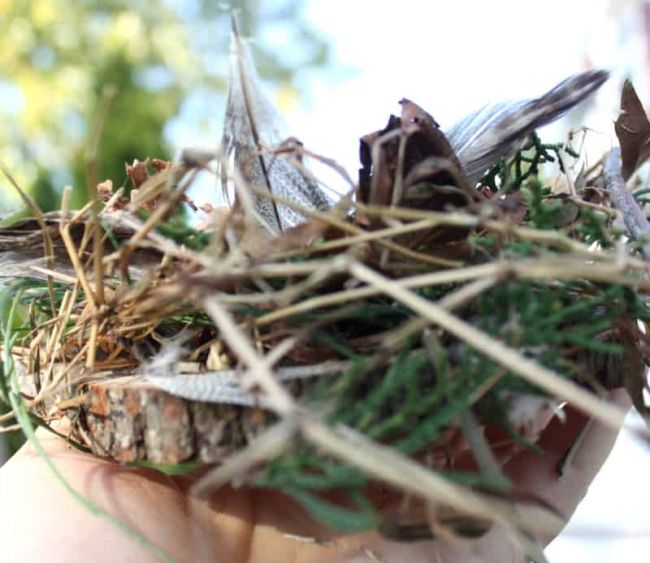
13. Assemble a nest
Birds build intricate nests, and they make it look easy. Can you do the same? Gather some materials outdoors, and try to make your own nest. (Easy)
Learn more: Build a Nest
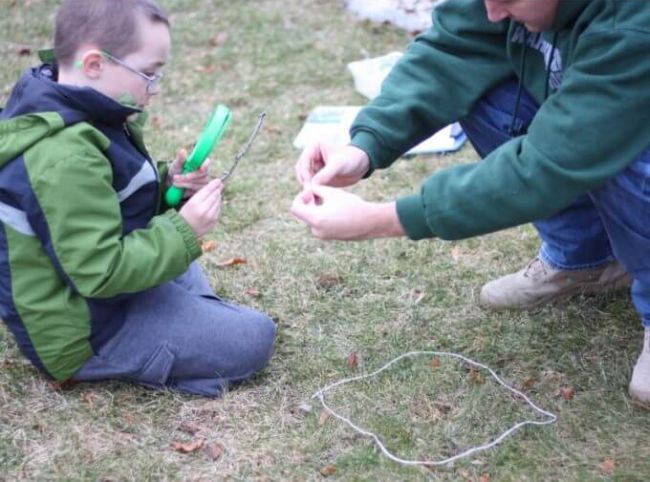
14. Explore 1 square foot
There’s an amazing amount of life in every square foot of nature. Grab your magnifying glasses or microscope, and take a closer look at the ground you walk on every day. (Easy)
Learn more: Square Foot Outdoor STEM Project
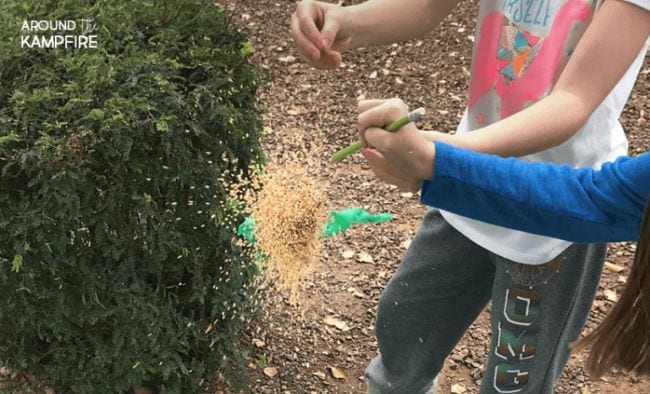
15. Explode a DIY seed pod
Find out how some plants spread their seeds far and wide with this cool balloon experiment. Fill it with seeds and air, then pop it outside on a breezy day and watch the seeds fly! (Medium)
Learn more: Seed Dispersal Activity
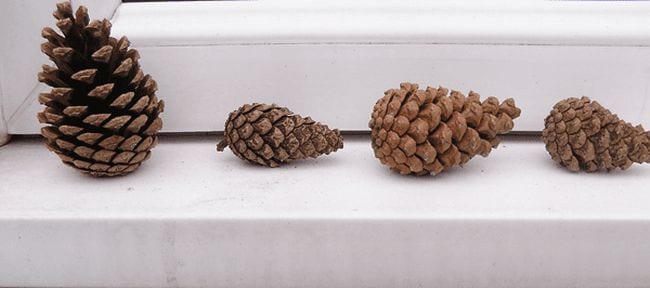
16. Forecast the weather with pine cones
Fun fact: Pine cones open and close according to the weather in order to protect or disperse the seeds inside. Use that fact to your advantage and create a pine cone weather station in your backyard. (Easy)
Learn more: Pine Cone Weather Station
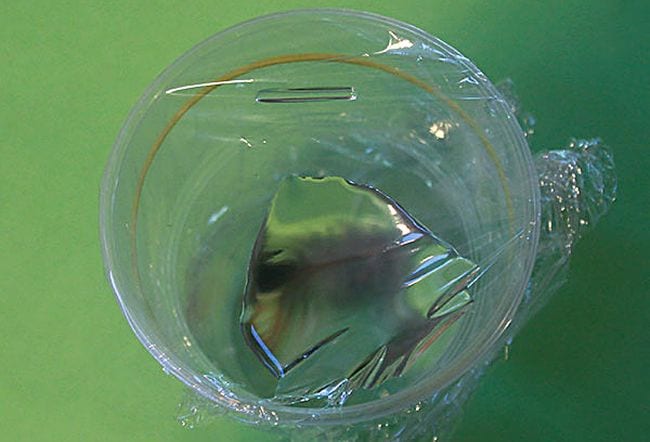
17. Put together a simple microscope
This DIY microscope isn’t very powerful, but it does magnify small objects so you can see details. It’s also really simple to make. Looking for a stronger microscope you can take on the go? Try this portable model that hooks up to your cell phone. (Easy)
Learn more: Mini Microscope
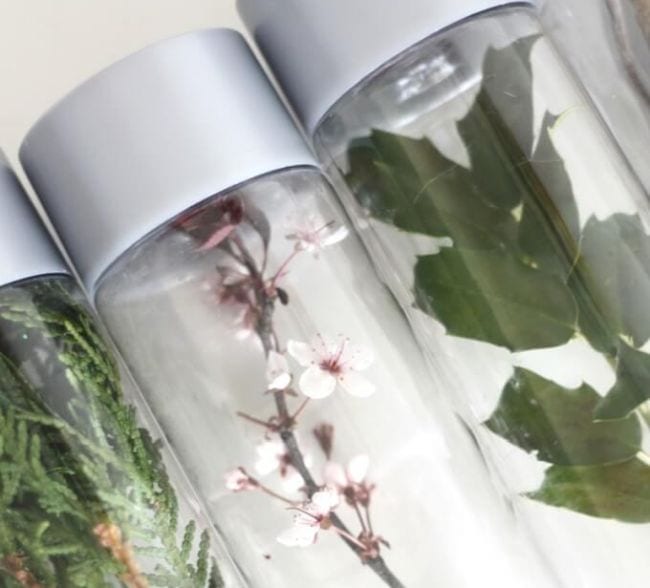
18. Create nature discovery bottles
Stroll through the great outdoors and have kids collect interesting natural objects. Use recycled soda or water bottles to display their specimens. (Easy)
Learn more: Nature Sensory Bottles
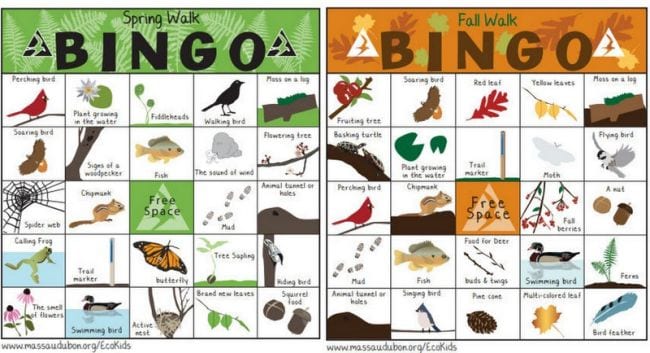
19. Play a game of Nature Bingo
Give your nature walk more direction by giving students specific items to seek out. You can make your own boards, or hit the link below for free printables for every season. (Easy)
Learn more: Nature Bingo
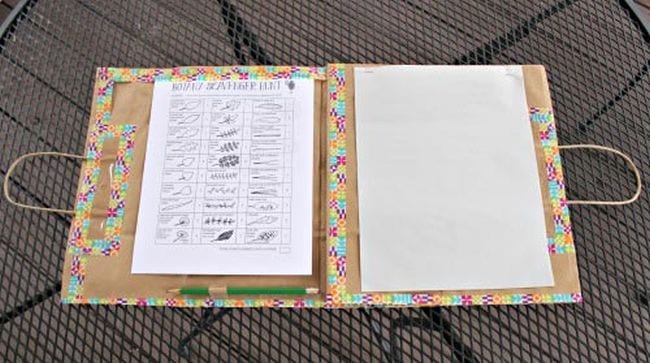
20. Start a nature journal
Nature journals are a great way to partner writing and outdoor science while building kids’ observational skills. You can use any sturdy notebook or check out the link below for free printable journal pages and a fun DIY carry-along journal project. (Easy)
Learn more: Nature Journal
21. Make and plant DIY seed bombs
Use recycled materials to create “seed bombs.” Then plant them in the schoolyard or send kids home to use them in their own gardens. Students learn about ecology, recycling, and plant life cycles. (Medium)
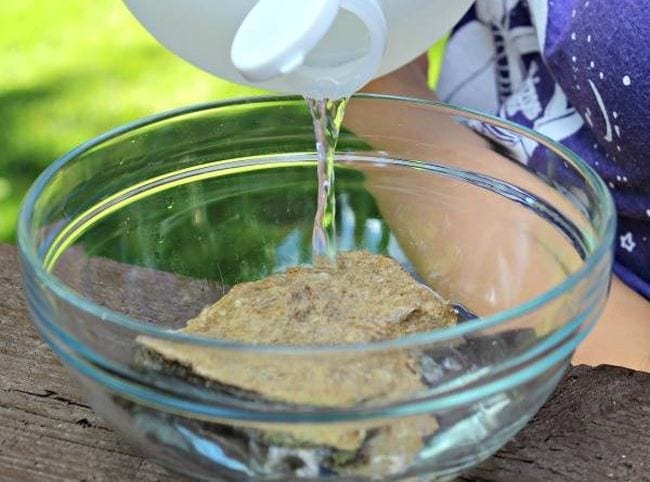
22. Experiment with limestone rocks
Kids love to pick up rocks, and there are plenty of great science experiments you can do with them. In this one, you pour vinegar over a rock to see if it bubbles. If it does, you’ve found limestone! (Easy)
Learn more: Vinegar and Limestone Test
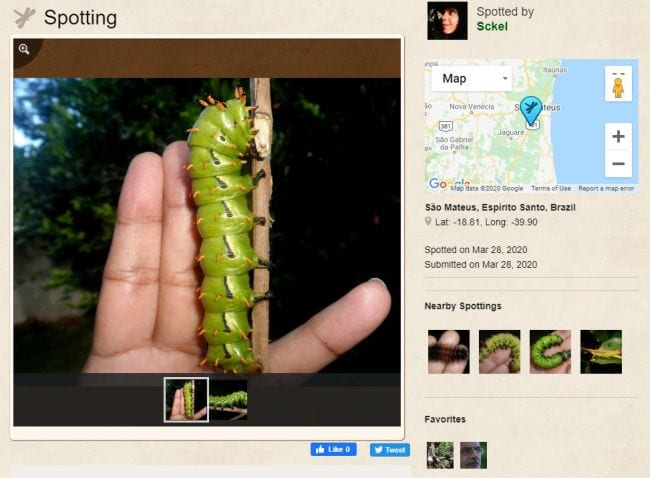
23. Contribute to citizen science
Use a cell phone to snap pictures of everything you find on a nature walk, then report those sightings to Project Noah. This citizen science project is dedicated to documenting every living thing on Earth! (Easy)
Learn more: Project Noah
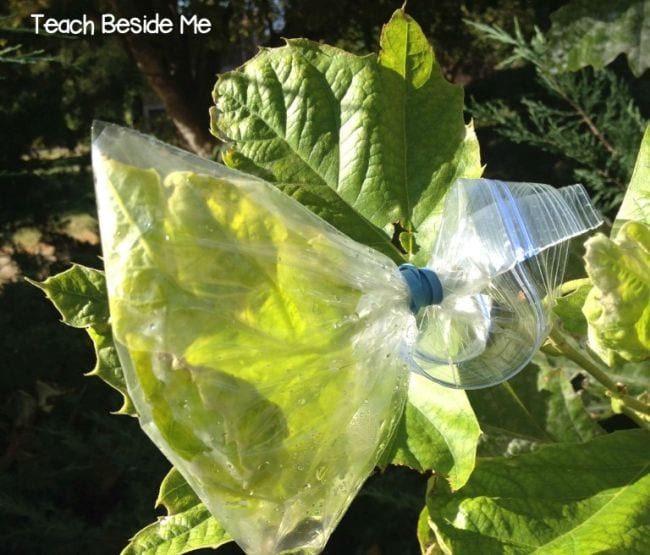
24. Learn about plant transpiration
This simple project demonstrates how plants get rid of excess water they don’t need, a process known as transpiration. The supplies and method are simple enough for anyone to try it. (Easy)
Learn more: Transpiration
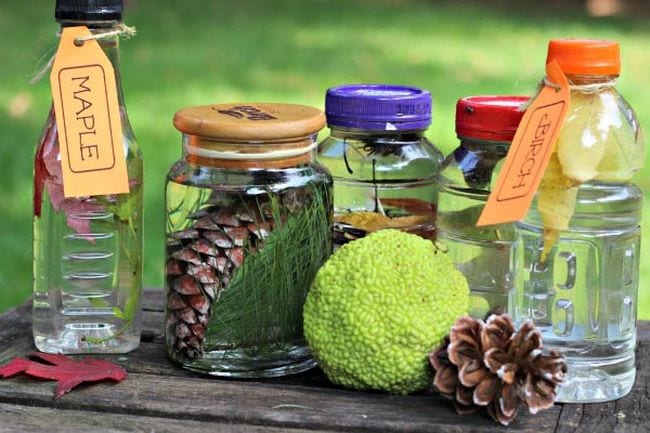
25. Learn to identify trees
Give trees a closer look and learn to identify them by their leaves and seeds. These jars preserve the leaves and seeds for future study too. (Medium)
Learn more: Tree ID Scavenger Hung
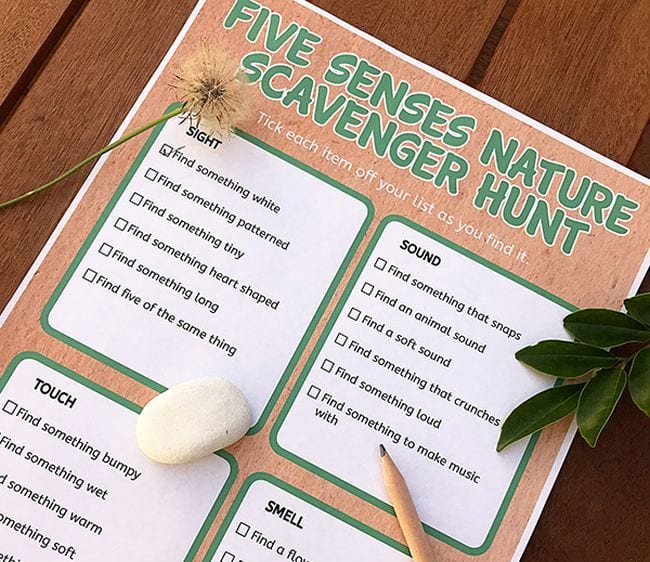
26. Go on a nature scavenger hunt
Take kids outdoors to use their five senses with this free printable scavenger hunt activity. They’ll hone their observation skills and learn so much about the world around them. (Easy)
Learn more: Nature Scavenger Hunt
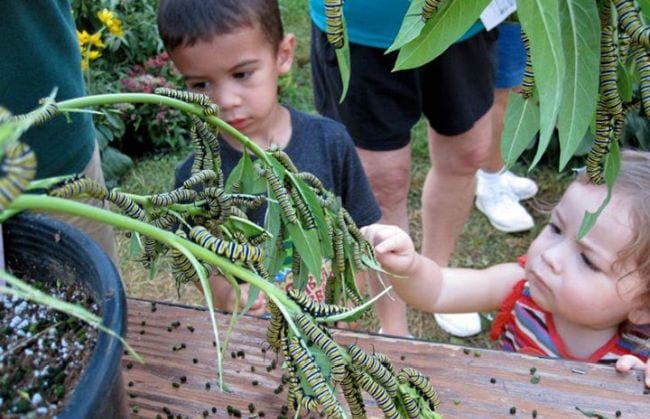
27. Help monarch butterflies
You may have heard that monarch butterflies are struggling to keep their populations alive. Join the fight to save these beautiful insects by planting your own butterfly garden, monitoring monarch populations, and more. Get all the info you need at the link. (Advanced)
Learn more: Monarch Watch
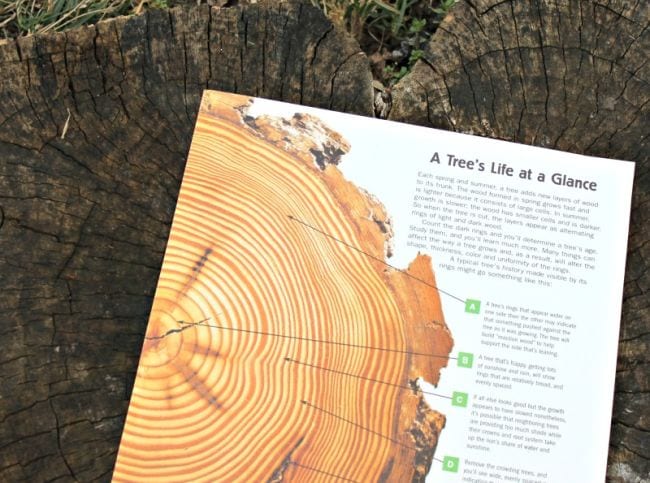
28. Count tree rings to explore dendrochronology
Your students might know you can count tree rings to find out how old a tree is, but do they know why that’s true? Students will undoubtedly get a kick out of exploring dendrochronology. (Medium)
Learn more: Tree Rings and Dendrochronology
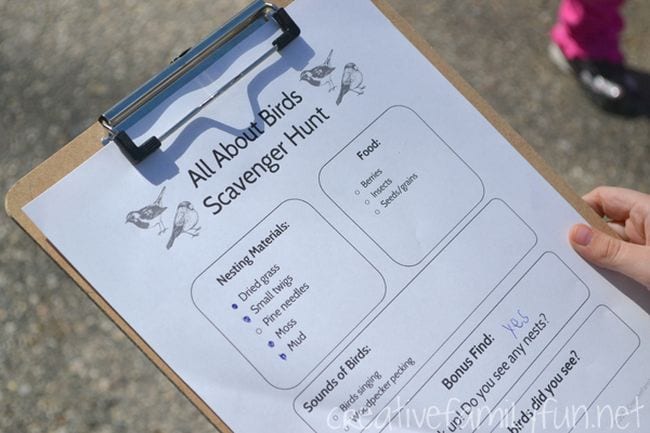
29. Seek out signs of birds
Have you ever noticed that birds can be difficult to spot, even though signs of them are all around? This free printable scavenger hunt helps you find evidence that birds live nearby. Just look for nests and food sources and listen for their sounds. (Medium)
Learn more: All About Birds Scavenger Hunt
30. Attract birds with a DIY bird feeder
Bring all the birds to the yard with this easy recycled bird feeder project. Kids can learn to identify common backyard birds in your area. Visit The Cornell Lab of Ornithology’s educators resource page for more ideas. (Easy)
31. Identify birds with an app
Some birds are easy to identify, but others stump even longtime bird-watchers. If you’re looking for outdoor science activities for kids who love feathered friends, check out the free Merlin Bird ID app. It listens to bird calls and identifies them in a snap! It works with photos too. (Easy)
Learn more: Merlin Bird ID
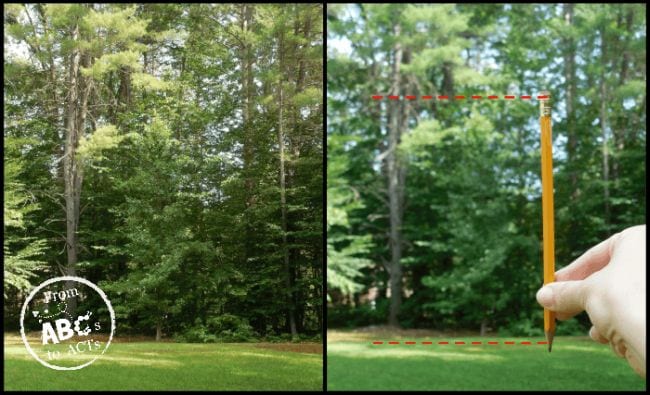

32. Estimate the height of a tree
Kids work in pairs to estimate the height of a tree in this project that puts the M in STEM. Get a free printable at the link below to walk you through the process. (Medium)
Learn more: Outdoor STEM: Measuring Tree Height
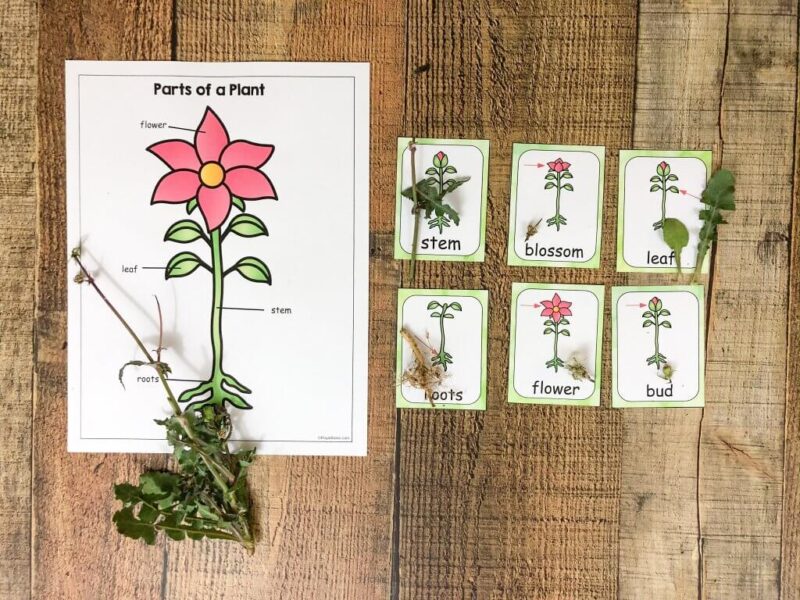
33. Dissect a flower
Take a plant apart to look at the various parts, like the roots, flower, bud, and more. (Medium)
Learn more: Investigating a Plant
34. Craft tree bark rubbings
Each tree has its type of bark, and making crayon rubbings is an easy and fun way to take a closer look. Put together a whole portfolio and label each with the kind of tree it comes from. (Easy)
35. Pit hydroponics against soil
Grow veggies using soil and hydroponics. Then, conduct your own taste test to see if one is better than the other. (Advanced)
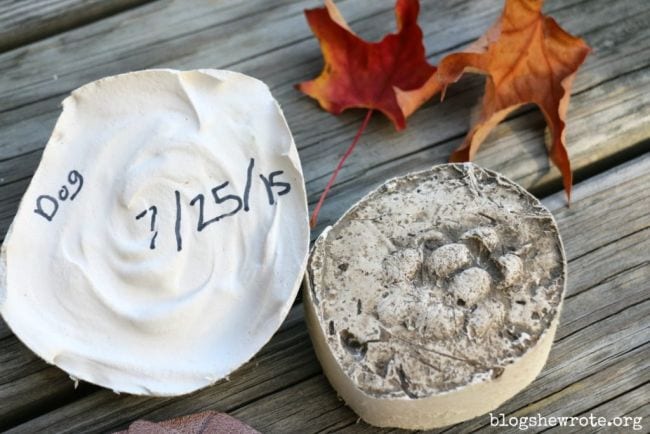
36. Cast animal tracks
Explore wildlife biology by becoming an expert tracker! Learn to identify tracks and take casts. Turn this into an experiment by trying different methods to take casts, or use it as a method of identifying wildlife in the woods. (Advanced)
Learn more: How to Find & Collect Animal Tracks

37. Gaze at the clouds
Look up and take some time to admire the clouds. Craft this cute “cloud viewer” and find a cloud in the sky. Then, identify what type it is, and learn more about how clouds form. (Easy)
Learn more: Make Your Own Cloud Viewer
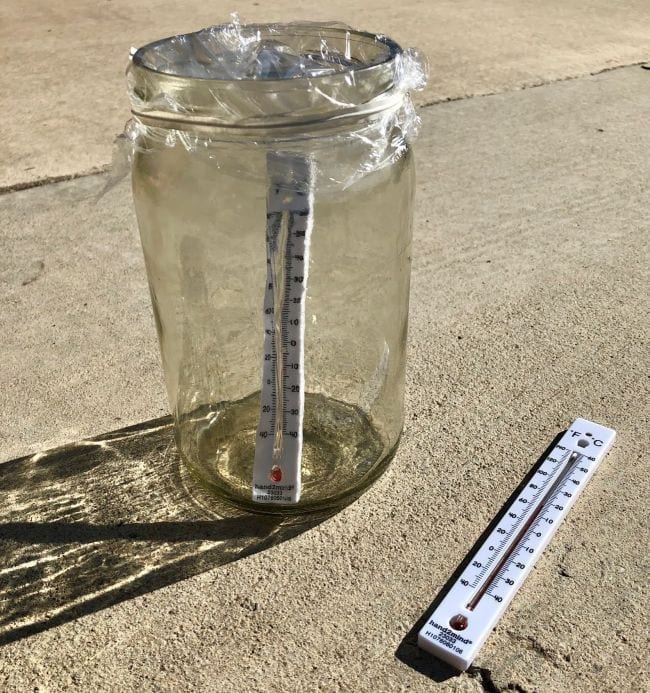
38. See the greenhouse effect in action
Climate change can be a contentious topic, so start by teaching kids about the greenhouse effect, which is easy to see and understand using this simple experiment. Then, urge them to explore data collected by scientists so they can learn to make informed decisions about topics like global warming. (Easy)
Learn more: Teaching About the Greenhouse Effect
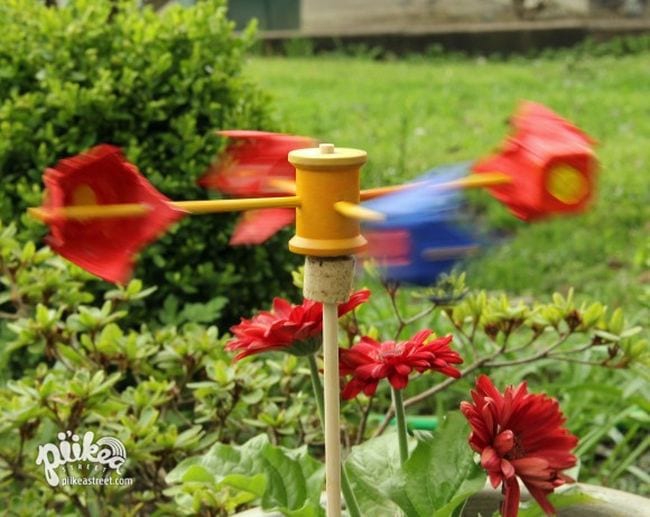
39. Assemble an anemometer
Scientists use anemometers to measure wind speed. Build this DIY version and do some outdoor science experiments about weather science with your kids. (Medium)
Learn more: Anemometer
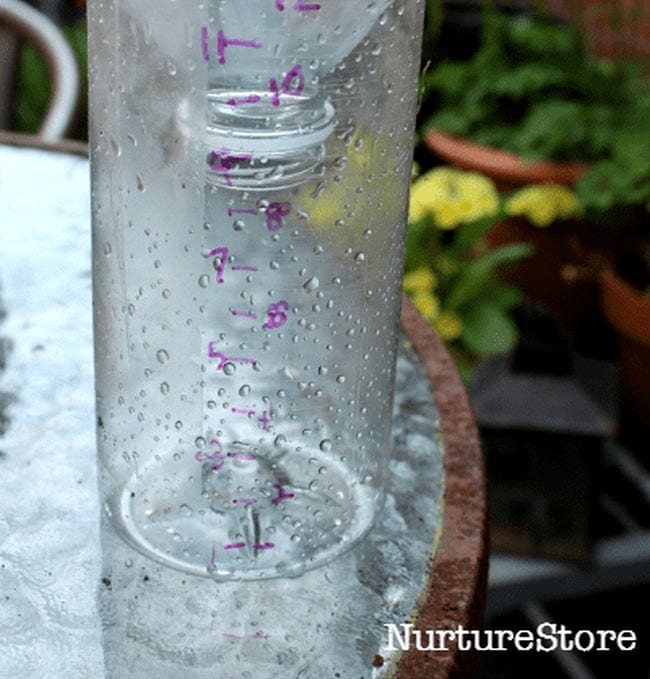
40. Turn a bottle into a rain gauge
All you need is a plastic bottle, a ruler, and a permanent marker to make your own rain gauge. Monitor your measurements and see how they stack up against meteorology reports in your area. (Medium)
Learn more: How To Make a Rain Gauge
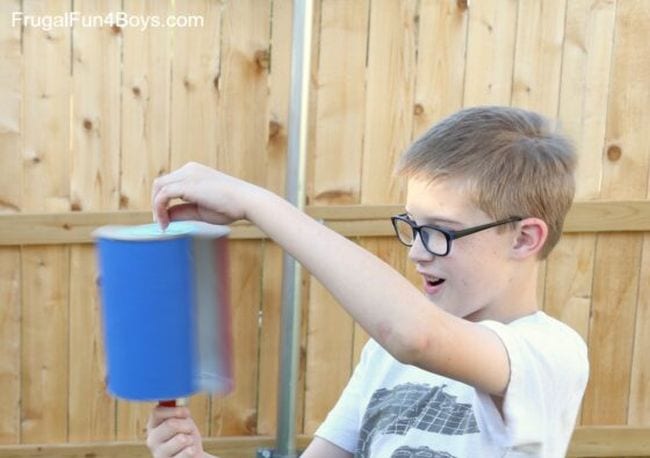
41. Harness the power of the wind
Wind turbines have become common sights in some parts of the country as we explore alternative energy sources. Build your own to learn how they work with this outdoor science experiment. (Medium)
Learn more: Build a Wind Turbine
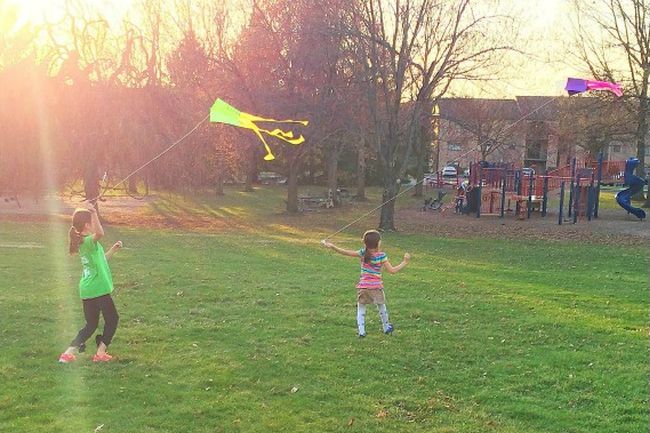
42. Fly a kite
You can learn a lot about physics when you make and fly your own kite. Experiment with different designs to see whose kite flies the highest or the longest. (Easy)
Learn more: How To Make a Simple Kite
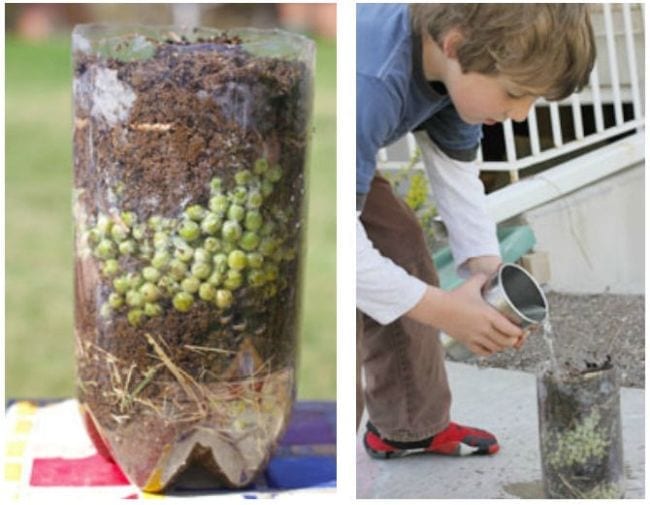
43. Compost food scraps in a bottle
Food waste is a big problem, contributing to much of the material that winds up in landfills. Teach kids how to compost with kitchen scraps in a plastic bottle, and use the compost to feed your plants. (Medium)
Learn more: Soda Bottle Compost
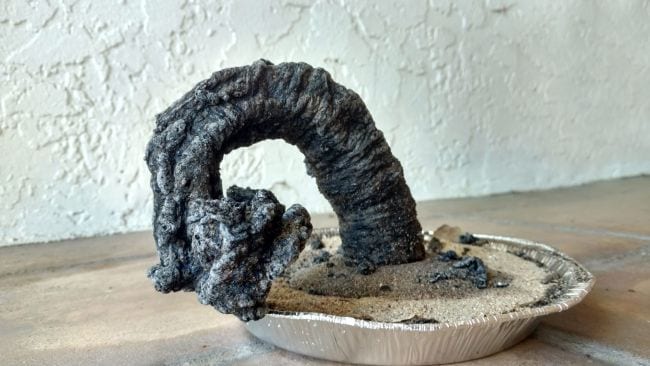
44. Grow a carbon sugar snake
If you’re looking for outdoor science experiments that are sure to excite your students, try this eye-popping chemical reaction demonstration. You only need simple supplies like sugar, baking soda, and sand, but the element of fire makes this experiment best done outdoors. (Medium)
Learn more: Carbon Sugar Snake
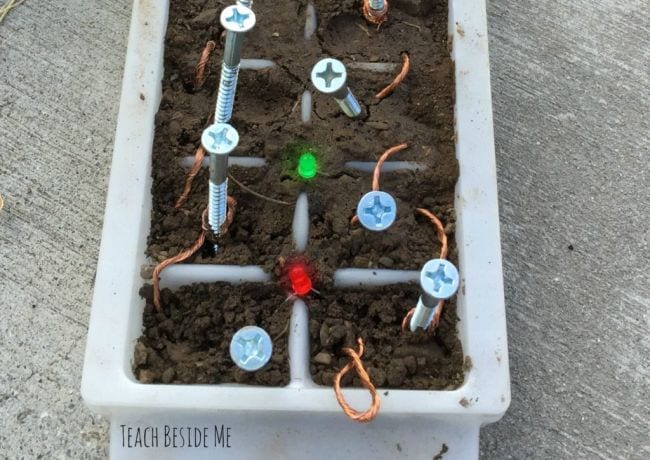
45. Construct a dirt battery
This outdoor science project is similar to building a battery from a lemon, but you also get to dig in the dirt! Kids learn about electric currents and conductivity. (Medium)
Learn more: Dirt Battery
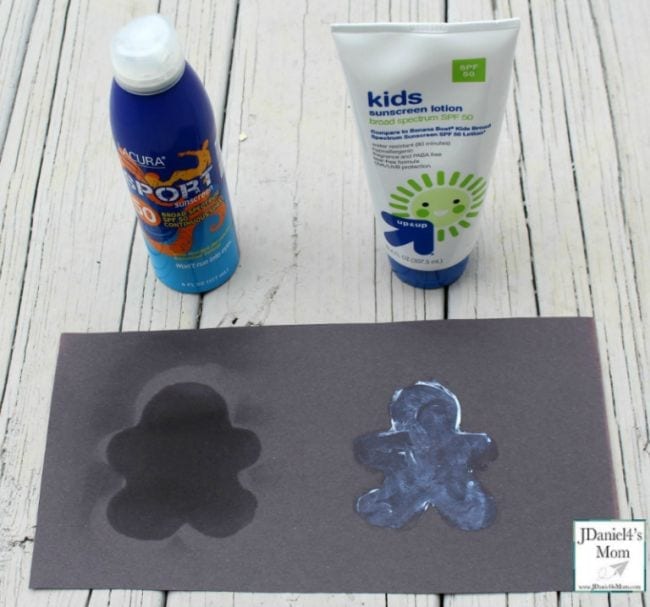
46. Test the power of sunscreen
We slather kids in sunscreen when they’re playing outside, but do they understand why? Try this fun little experiment, which demonstrates how sunscreen protects from the sun’s harmful rays. (Easy)
Learn more: STEM Sunscreen Experiment
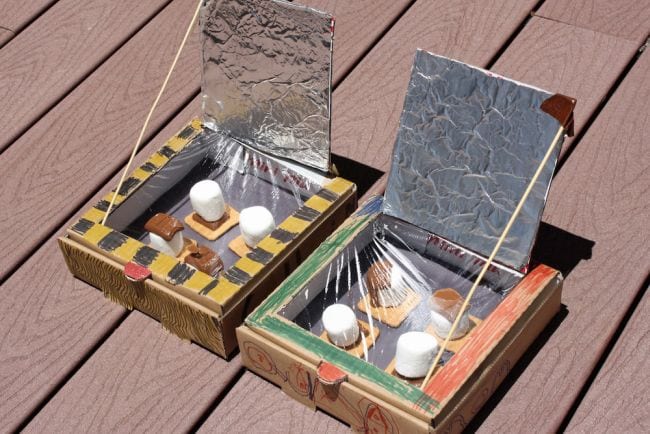
47. Build a solar oven
Explore the power of the sun when you build your own solar ovens and use them to cook some yummy treats. (Medium)
Learn more: Solar Oven
48. Blast off with bottle rockets
Just a few simple supplies let you use the power of air pressure to send a homemade bottle rock soaring to the heavens! Get full instructions in the video. (Medium)
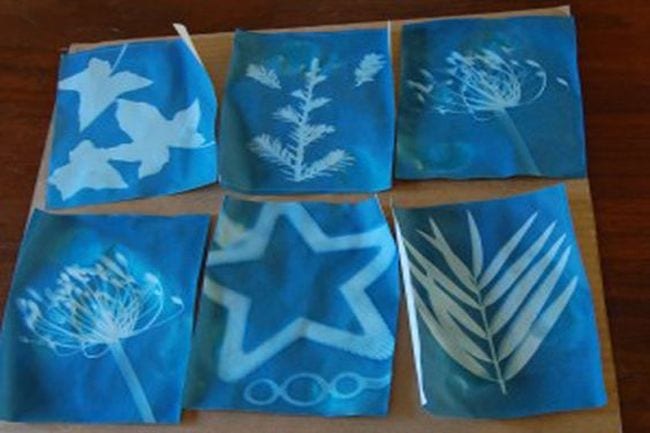
49. Make sun prints
You’ll need to buy special paper for this outdoor science project, but it’s easy to find. Kids will love creating their own patterns and experimenting to find which objects work best. (Medium)
Learn more: Sun Prints
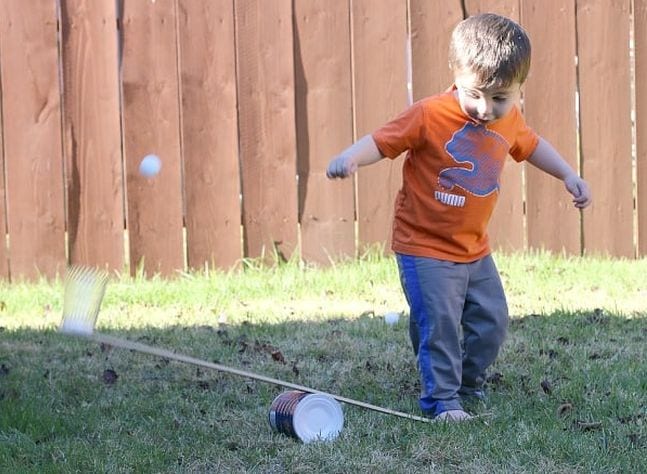
50. Launch Ping-Pong balls with a catapult
Young kids will simply adore building this basic catapult and watching Ping-Pong balls soar! Older kids can experiment by changing the position of the fulcrum, the length of the board, and the objects being flung. (Easy)
Learn more: DIY Catapult
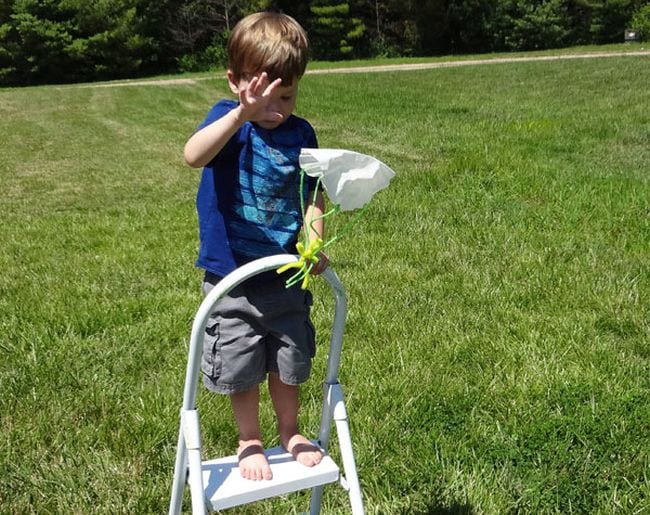
51. Test out parachutes
Gather a variety of materials (try tissues, handkerchiefs, plastic bags, etc.) and see which ones make the best parachutes. You can also find out how they’re affected on windy days or find out which ones work in the rain. (Easy)
Learn more: How To Make a Parachute
52. Swing a glass of water to learn about centripetal force
When you do this experiment right, you won’t make a mess at all. But while kids are still getting the hang of swinging glasses of water around their heads, you’ll probably want to make this an outdoor science activity. (Medium)
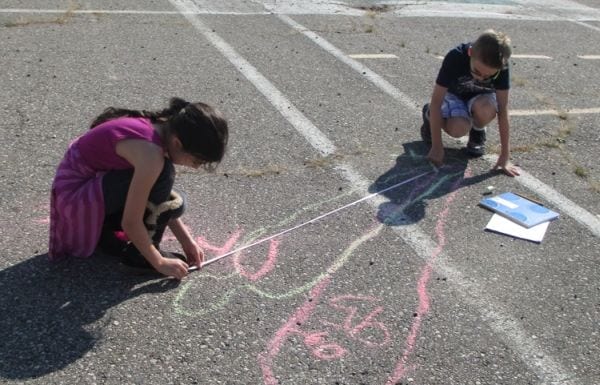
53. Become a human sundial
Choose a sunny day and grab some sidewalk chalk—your students are about to become sundials! They’ll practice measuring skills and learn about the movement of the sun across the sky. (Easy)
Learn more: Human Sundial
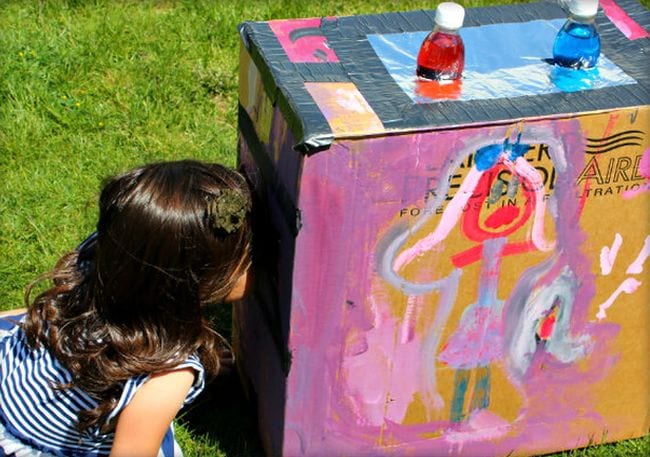
54. Build a light box
Kids can entertain themselves for hours with a big empty cardboard box. Channel that energy by turning a box into a place to learn about light refraction and reflection, using colored water in plastic bottles. (Medium)
Learn more: Light Box
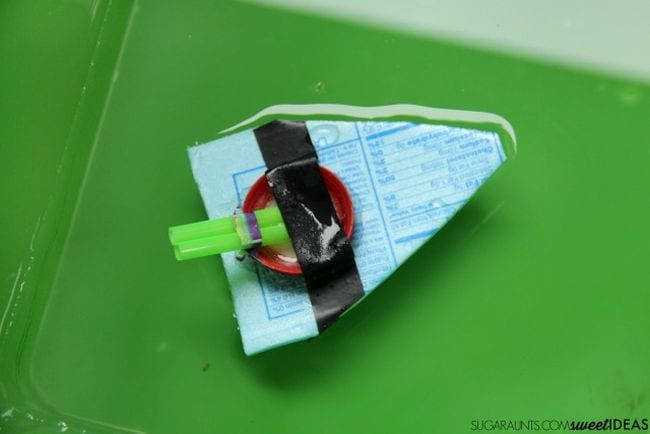
55. Float a baking soda–powered boat
Here’s another experiment using the classic baking powder and vinegar reaction. This one uses it to power these cute little DIY boats! A kiddie pool is the perfect spot for this outdoor science project. (Medium)
Learn more: Baking Soda Boat
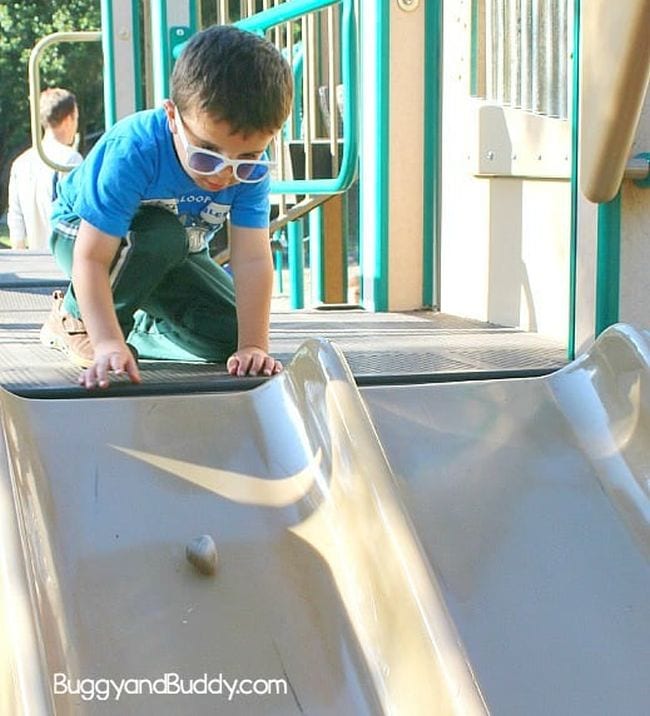
56. Slide into friction science
Head out to the playground, gather up a variety of objects, and hold races to see which ones make it down the slide first. This is a fun introduction to friction and inclined planes. (Easy)
Learn more: Exploring Ramps and Friction on a Slide
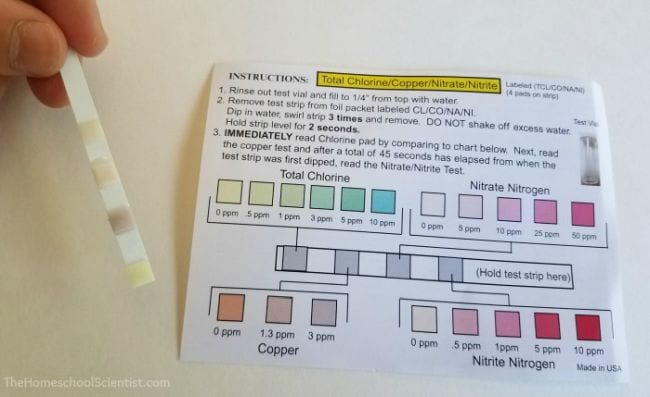
57. Test your local water quality
Once you’ve “cleaned up” your water, try testing it to see how clean it really is. Then head out to test other types of water. Kids will be fascinated to discover what’s in the water in their local streams, ponds, and puddles. Water-testing kits are readily available online— try this set available on Amazon . (Advanced)
Learn more: Water Quality Experiment
58. Make a rainbow
Spotting a rainbow in the sky is always a magical experience. Let kids experiment with different methods to learn how they can create rainbows of their own, anytime they like! (Easy)

59. Send a tea bag flying
Hot air rises, and this experiment can prove it! You’ll want to supervise kids with fire, of course, but this is a really cool concept to see in action. (Medium)
Learn more: Flying Tea Bag Experiment
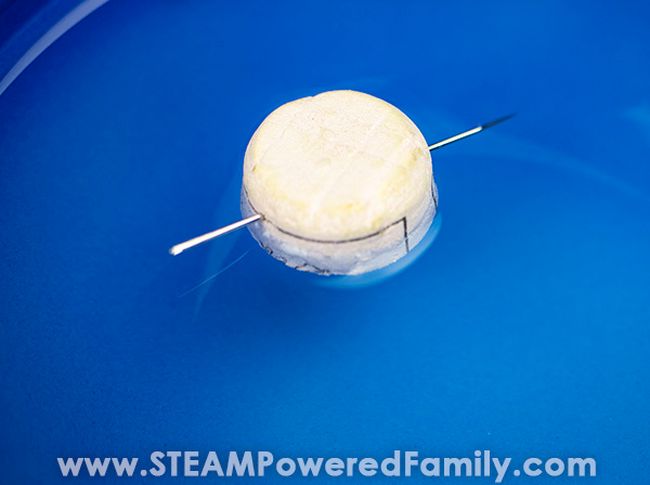
60. Find your way with a DIY compass
Here’s an old classic that never fails to impress. Magnetize a needle, float it on the water’s surface, and it will always point north. (Easy)
Learn more: Simple Magnetic Compass
61. Make a solar desalinator
Clean freshwater is a valuable commodity. Construct solar-powered desalination devices with readily available materials, and find the most effective desalination methods. (Advanced)
Outdoor science experiments don’t have to be limited to spring or summer! Bookmark the Coolest Winter Science Experiments and Activities .
Plus, get all the latest teacher tips and tricks, straight to your inbox, when you sign up for our newsletters .

You Might Also Like
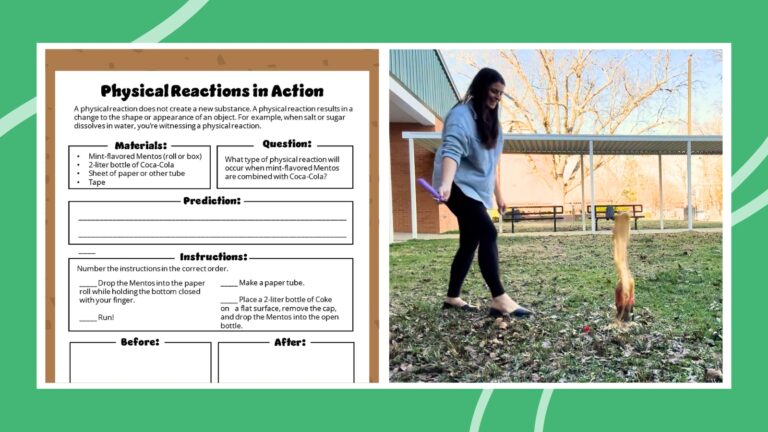
Mentos and Coke Experiment: How-To Plus Free Worksheet
This explosive experiment teaches kids about physical reactions. Continue Reading
Copyright © 2024. All rights reserved. 5335 Gate Parkway, Jacksonville, FL 32256
- History & Overview
- Meet Our Team
- Program FAQs
- Social Studies
- Language Arts
- Distance Learning
- Population Pyramids
- World Population “dot” Video
- Student Video Contest
- Lower Elementary (K-2)
- Upper Elementary (3-5)
- Middle School (6-8)
- High School (9-12)
- Browse all Resources
- Content Focus by Grade
- Standards Matches by State
- Infographics
- Articles, Factsheets & Book Lists
- Population Background Info
- Upcoming Online Workshops
- On-Demand Webinar Library
- Online Graduate Course
- Request an Online or In-person Workshop
- About Teachers Workshops
- About Online Teacher Workshops
- Pre-Service Workshops for University Classes
- In-Service Workshops for Teachers
- Workshops for Nonformal Educators
- Where We’ve Worked
- About the Network
- Trainer Spotlight
- Trainers Network FAQ
- Becoming a Trainer
- Annual Leadership Institutes
- Application

Environmental Science Fair Projects: 30 Eco Friendly Ideas
By Pam Wasserman | March 20, 2014
It’s that time of year again when the presentation boards come out – Science Fair Season. While there are innumerable science topics for kids to choose for their research, we thought it would be helpful to offer suggestions that relate to environmental science. With Earth Day and Science Fairs on the horizon, there are many great themes to help students examine an environmental topic in depth and educate their classmates and parents at the same time. Here are some ideas for environmental science fair projects:
Water Science Fair Projects: 1. How does the water cycle work? [Create a working model] 2. Where does fresh water come from? [Do the demonstration in “ Water, Water Everywhere .”] 3. How do we clean dirty water to make it clean enough to drink? [Demonstrate different filtering techniques.] 4. Why is water scarce in parts of the world and who is most affected? 5. What are the main culprits of water contamination? [Do the demonstration in “ Like Water and Oil ” to show the effects of oil spills.] 6. What are water-borne diseases and how do they affect public health?
Air Quality Science Fair Projects: 7. How does polluted air affect human health? [Show the effect of pollutants on the respiratory system.] 8. How does transportation affect air quality? [Do the experiment in “ Catching Pollution .”]
Climate Change Science Fair Projects: 9. What is the greenhouse effect? [Create a model] 10. How do certain human activities contribute to global warming? 11. What do ice core samples tell us about the history of global temperatures? 12. How does climate change affect the habitats and migration patterns of different species? 13. What are the consequences of global sea level rise? [Map the effects of various sea level increases, showing where impacts occur.]
Biodiversity Science Fair Projects: 14. What are invasive species and why might they pose a threat to different ecosystems? [Use a local example from your area – your County’s Extension Office is a good place to research.] 15. How have we derived medicines from different plants and animals? 16. What are the major threats to biodiversity?
Agricultural Science Fair Projects: 17. What are the pros and cons of genetically modified foods (GMOs)? 18. Can we feed the world with organically grown foods? 19. What are the short and long-term effects of commercial fertilizer use on the land? 20. What sort of diet would be optimal for human health and the environment? [Calculate the ecological footprint of various diets.] 21. Has the amount of arable land changed over time and how might this help predict future cropland availability? [Use “ World Real Estate ” to chart historical changes in the amount of arable land per person.] 22. How might climate change affect crop yields in different parts of the globe?
Renewable Energy Science Fair Projects: 23. How do solar panels work? How about wind turbines? 24. What is geothermal energy and how is it used?
Solid Waste Recycling Science Fair Projects: 25. Which materials decompose the fastest in landfills? In compost piles? [Try “ Scraps into Soil ” to get started and see results over time.] 26. Paper vs. Plastic – Which kind of bag has the greater impact on the environment and why? 27. How can changes in daily habits change the amount of trash we create? [Do the experiment in “ Waste A-Weigh .”]
Population Themed Science Fair Projects: 28. What is carrying capacity in nature and what happens when different species exceed the carrying capacity? [Read “ How Many is Enough? ” to learn the basics of carrying capacity.] 29. How does reproduction vary among different species (ex. number of offspring, length of gestation, mating habits)? 30. How and why did human settlements change over time and what effect have these changes had on ecosystems?
Related Resources
Classroom filmmaking: 5 exciting ways to teach global issues using 21st century skills.
Technology integration is a hot topic in the field of education. In today’s modern job market, it is imperative... Read More »
Environmental Literacy and Population Education
This post will conclude our discussion of 21st Century Skills and Population Education we have been having throughout the... Read More »
About Population Education
Population Education provides K-12 teachers with innovative, hands-on lesson plans and professional development to teach about human population growth and its effects on the environment and human well-being. PopEd is a program of Population Connection. Learn More About PopEd .
Privacy Overview

An official website of the United States government
Here’s how you know
Official websites use .gov A .gov website belongs to an official government organization in the United States.
Secure .gov websites use HTTPS A lock ( Lock A locked padlock ) or https:// means you’ve safely connected to the .gov website. Share sensitive information only on official, secure websites.
JavaScript appears to be disabled on this computer. Please click here to see any active alerts .
Science Fair Environmental Project Ideas
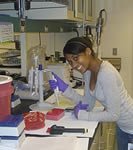
Need an idea for a science fair project or some help? Check out the resources below.
Ideas for Science Fair Projects on Surface Water Quality Topics for Middle Schools Students and Teachers - Ideas for science fair projects on surface water quality from EPA's Office of Water. These projects address real-life water issues occurring in streams, rivers, lakes, and other types of surface waters across the United States.
Science Fair Fun: Designing Science Fair Projects - This EPA booklet provides students in grades 6-8 with ideas and resources for developing environmental science fair projects about reducing, reusing, and recycling waste materials.
Energy Kids: Science Fair Experiments - Want to learn about energy or do a science fair project on energy? This site will give you project ideas and throw in some fun things as well. From the U.S. Energy Information Administration.
Science Fair Projects for Kids - Links to tons of science fair project ideas! From USA.gov.
Learning and Teaching about the Environment
- Science, Tech, Math ›
- Chemistry ›
- Projects & Experiments ›
Environmental Science Fair Projects
- Projects & Experiments
- Chemical Laws
- Periodic Table
- Scientific Method
- Biochemistry
- Physical Chemistry
- Medical Chemistry
- Chemistry In Everyday Life
- Famous Chemists
- Activities for Kids
- Abbreviations & Acronyms
- Weather & Climate
- Ph.D., Biomedical Sciences, University of Tennessee at Knoxville
- B.A., Physics and Mathematics, Hastings College
Are you interested in doing a science fair project that involves the environment, ecology, pollution, or other environmental issues? Here are some science fair project ideas that involve environmental science problems.
Environmental Processes
- Does the pH of rain or other precipitation (snow) vary according to the season?
- Is the pH of rain the same as the pH of soil?
- Can you use a plant to gauge the level of air pollution?
- Can you use plants to remove air pollutants?
- Can you use algae to remove water pollutants?
- How does soil composition change with depth?
- What organisms can you use as indicator organisms to alert you to a dangerous environmental condition in the environment?
- How can you simulate acid rain?
Studying Environmental Damage
- What effect does the presence of phosphates have, if any, on the oxygen level of water in a pond?
- How does an oil spill affect marine life?
- How much lead is in your soil? How much mercury is in your soil?
- How much electronic pollution is there in your home? Can you find a way to measure it?
- How much copper can plants tolerate?
- How does the presence of soap or detergent in water affect plant growth? What about seed germination or propagation?
- How far away from an animal pen do you need to be for there to be no fecal bacteria contamination of the soil or water?
Researching Solutions
- Can you use gray water (water that has been used for bathing or washing) to water your plants? Does it matter what type of soap you used for your cleaning? Are some plants more tolerant of gray water than others?
- Are carbon filters as effective with chlorinated or fluoridated water as they are with water that does not contain chlorine or fluoride?
- How can you minimize the volume taken up by trash?
- How much trash can be recycled or composted?
- How can you prevent soil erosion?
- What type of car antifreeze is most friendly to the environment?
- What type of de-icer is most friendly to the environment?
- Are there non-toxic methods that can be used to control mosquito populations?
- Chemistry Science Fair Project Ideas
- Plant and Soil Chemistry Science Projects
- Science Fair Project Help
- Science Fair Experiment Ideas: Food and Cooking Chemistry
- Science Fair Project Ideas
- College Science Fair Projects
- Science Fair Project Ideas for 12th Graders
- 5th Grade Science Fair Projects
- 8th Grade Science Fair Project Ideas
- 3rd Grade Science Fair Projects
- Sports Science Fair Project Ideas
- Magnetism Science Fair Projects
- 7th Grade Science Fair Projects
- Crystal Science Fair Projects
- 10th Grade Science Fair Projects
- Household Product Testing Science Fair Projects
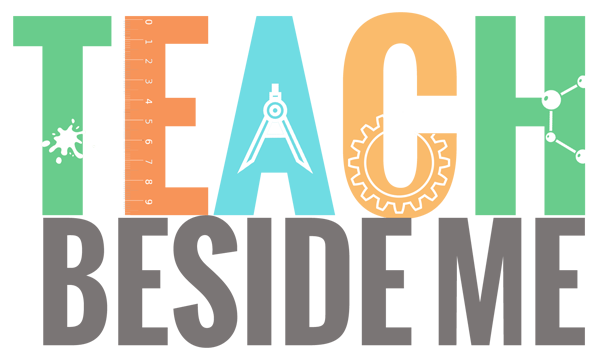
Environmental Science: Oil Spill Clean Up Experiment
This post may contain affiliate links.
Oil Spills are tragic events and I am always so sad when there is a large oil spill in the ocean. My kids and I did some environmental science this week by doing an Oil Spill Clean Up Experiment . This is a perfect classroom Earth Day STEM project for kids in elementary through middle grades. See more STEM projects HERE .
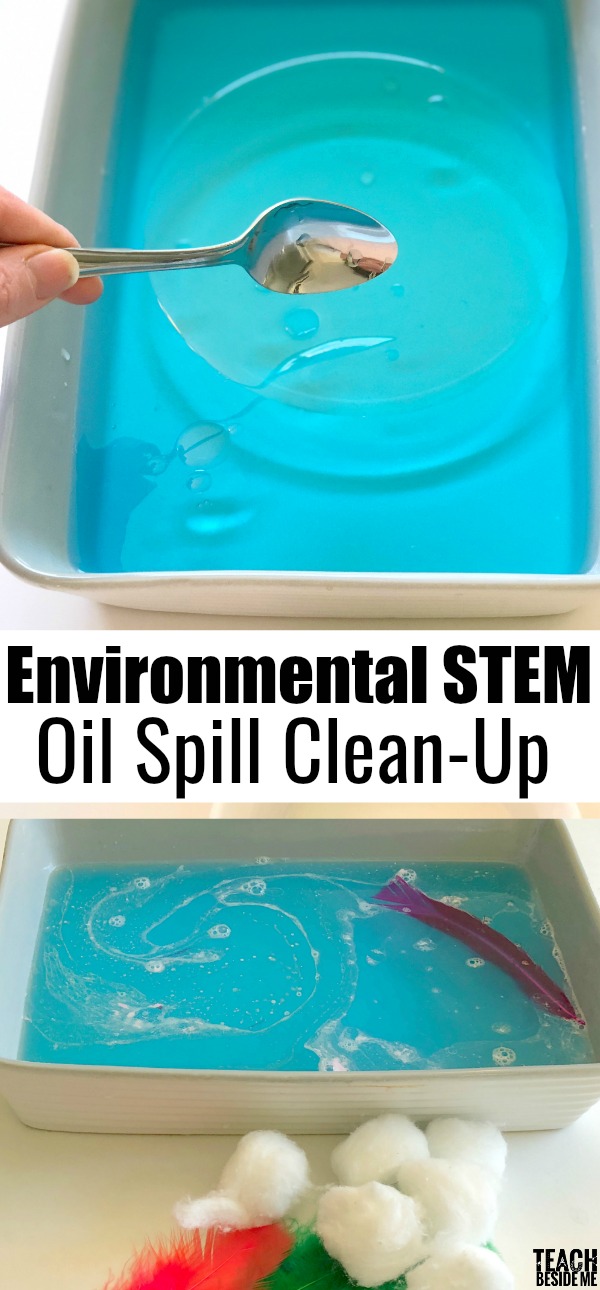
The term oil spill usually refers to ocean spills, but they also occur on land. Today our oil spill clean-up experiment focuses on the ocean spills. The oil comes from off-shore drilling, from accidents with oil tankers in the ocean, or other large ships dumping or spilling their waste oils.
Obviously something like this causes a major disaster in the ecosystem killing wildlife such as plants and animals in the surrounding area. These disasters can take weeks months and sometimes years of restoration to clean up all of the after effects of these spills. Not only does it affect animals in the ocean, but the habitats of those along the shoreline as well. It is not an easy process. Accidents like this always are heartbreaking to me!
For kids, it is an important thing to learn about. I want my kids to understand the importance of keeping our environment clean and safe.
We did an experiment testing a few ways to clean up our own oil spill. While the different methods we use in our home may not match up to what the amazing scientists use now, it brought awareness to my kids. They began to understand how hard it is to remove the oil from the water, and how much time it must take when hundreds of thousands of gallons are released into the ocean.

This oil spill experiment pairs perfectly with the Let’s Read and Find Out Science book: Oil Spill by Melvin Berger.
How to Do The Oil Spill Clean-Up Experiment
You will need the following supplies:

A Pan of Water Blue Food Coloring (optional, but fun!) Vegetable or motor oil Cotton Balls Bird Feathers Paper towels Dish Soap A Spoon
Fill a pan with water. Add blue food coloring to the water to make the distinction between the water and the oil more obvious.
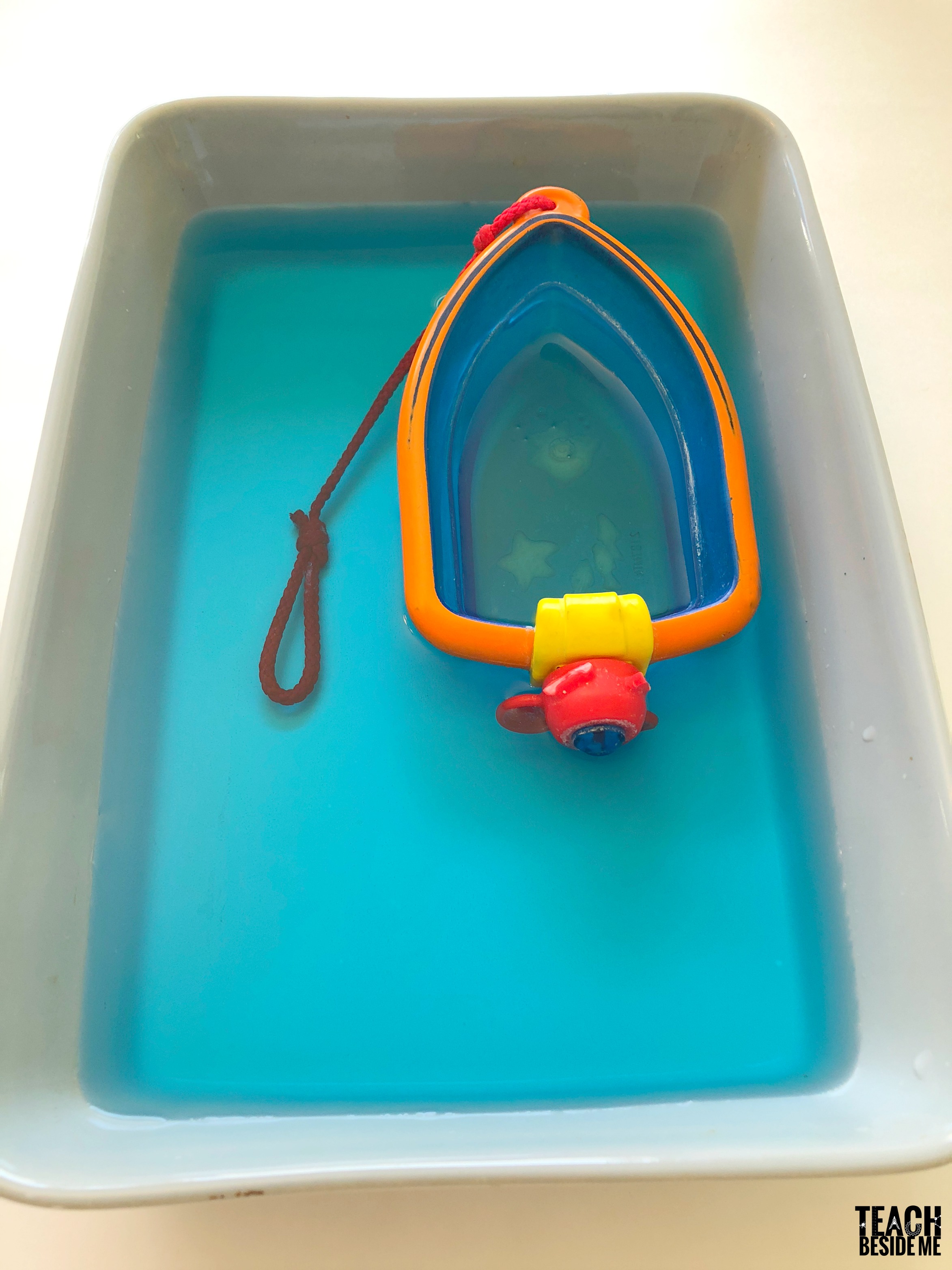
To make it more fun, I poured vegetable oil into a small toy boat that we had and let the kids dump it into the water that way. It could also be poured straight into the water. We used about 1/4 c. vegetable oil. The oil will sit on the surface of the water.
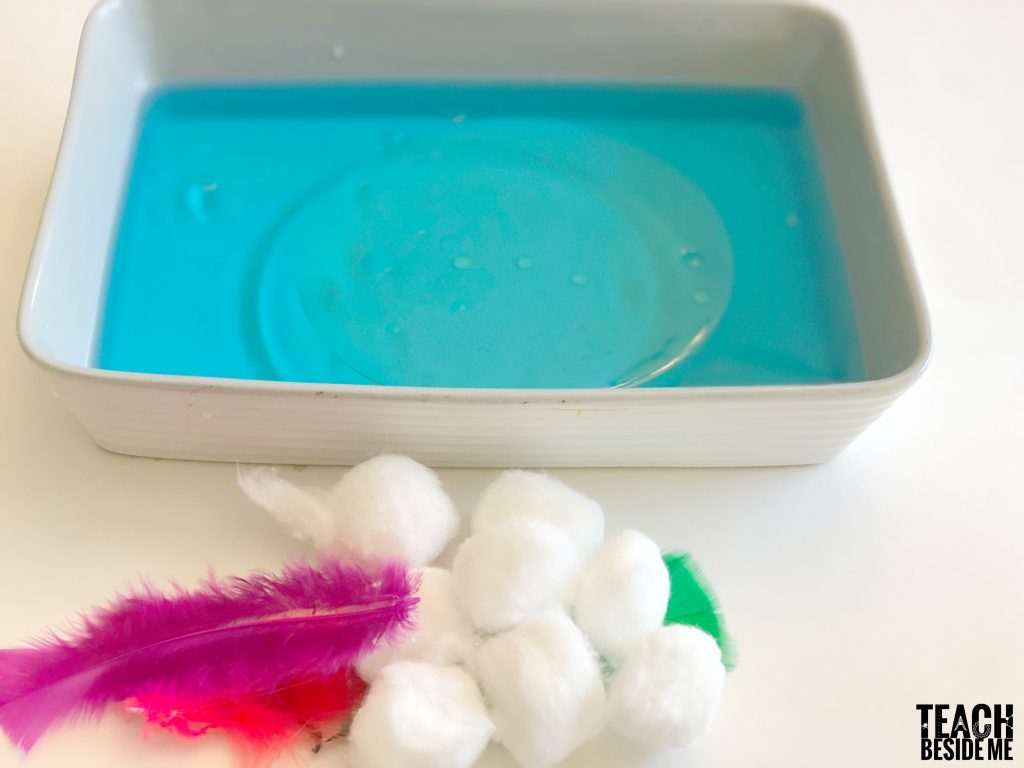
Give kids a chance to come up with a hypothesis of what absorbers will work best to clean up the oil. Now use various cleanup methods to try to remove the oil from the water. We tried spooning it out, using cotton balls and feathers, paper towels, and a sponge. The kids decided the spoon is easiest, but they all take a long time.
The feathers were a disaster to try to use. This lead to a discussion about how birds get covered in oil and it is hard to clean them. It also gets stuck in animal fur. Soap is often used to do this. We tried washing the feathers with soap. It was messy, but did get it clean.
Over all the oil spill clean-up experiment was a great project to do with the kids. They learned a lot and really enjoyed the experience. I hope you’ll add this resource to your lesson plan!
Extend the learning by studying about the 2010 Gulf of Mexico oil spill when 4.9 million barrels of petroleum spilled into the Gulf. There was an explosion on board the ship which also killed 11 men. It was really a huge tragedy.
Try More Earth Day themed activities:
Water Filtration Experiment
How to Make a Solar Still
Leaf Transpiration Experiment
Earth Fractions ~Earth Day Math
This post is part of the Storybook Science Series hosted by Inspiration Laboratories . Hop on over there to see the posts from other bloggers.

Explore More
Former school teacher turned homeschool mom of 4 kids. Loves creating awesome hands-on creative learning ideas to make learning engaging and memorable for all kids!
Similar Posts

Evergreens and Pinecones (Nature Study & Craft)

Osmo Coding Kit for Kids

Icebreaker Getting to Know You Activities for Kids
3d coin art structures.
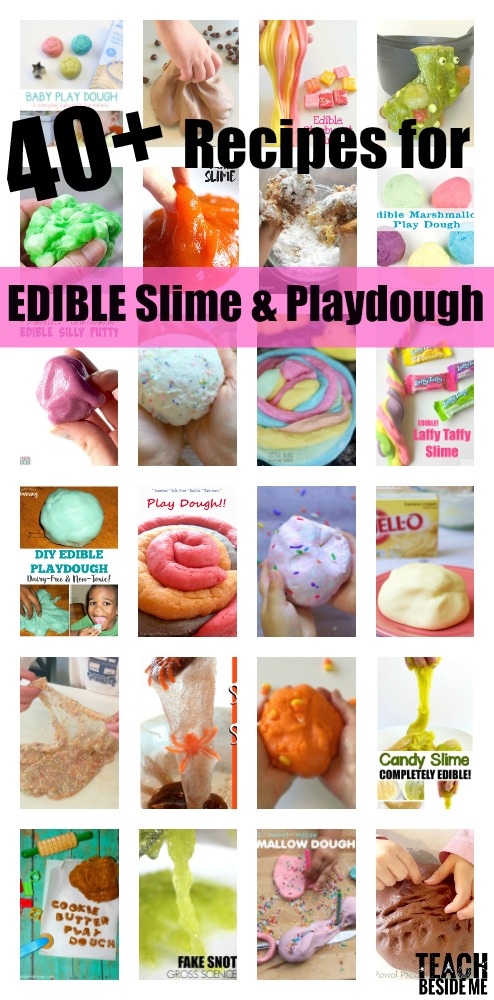
40+ Edible Slime and Play Dough Recipes

How to Make a Book With One Piece of Paper
One comment.
I am using this experiment for a presentation on oil spills with a group of seniors. I am adding a boom & skimmer and talking about some of the chemistry, but I would not have had this idea if it wasn’t for you ☺ Thanks!
Leave a Reply Cancel reply
You must be logged in to post a comment.
